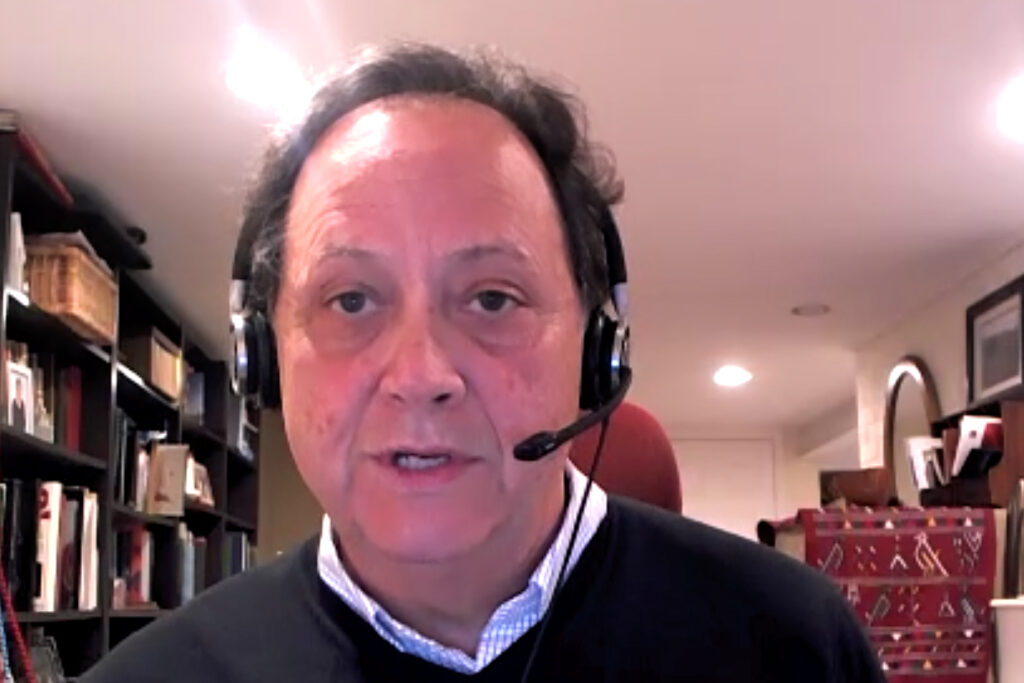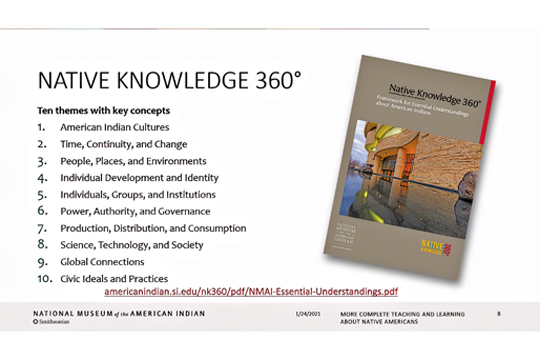2021
Webinar — 7 December 2021 – 7:00 pm – 8:00 pm
Global Competence: Teaching And Learning in an Interconnected World
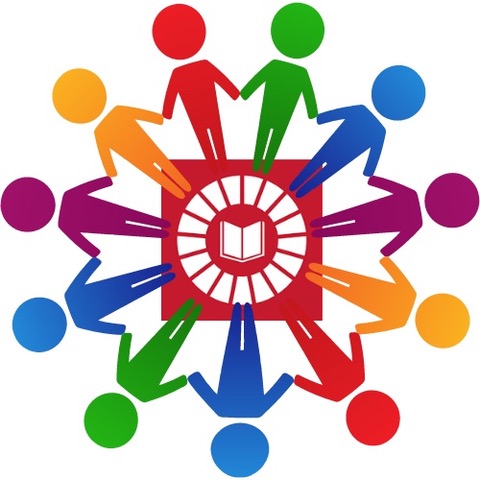
Each of the United Nations’ 17 Sustainable Development Goals comes with Targets. Target 4.7 of Goal 4, Quality Education, is “to ensure that all learners acquire the knowledge and skills to promote sustainable development, including, among others, through education for sustainable development and sustainable lifestyles, human rights, gender equality, promotion of a culture of peace and non-violence, global citizenship and appreciation of cultural diversity and of culture’s contribution to sustainable development by 2030.”

Global competence education focuses on the skills, values, and behaviors that prepare children to thrive in a diverse, interconnected world. This includes critical thinking, communications across diverse audiences, respect for different cultures and perspectives, and taking action to apply learning.
This webinar aimed to define global competence, explain why it is essential for today’s learners and show how it has been implemented in various programs.
Speakers:
William [Bill] Gaudelli is 8th Dean and Professor of the College of Education of Lehigh University and Vice Provost of Innovation in Education at Lehigh University [Bethlehem, PA]. His research areas include global citizenship education and teacher education/development. He was previously a professor of social studies at Teachers College, Columbia University for 12 years, 4 of which he served as chair of the Department of Arts and Humanities. Gaudelli has published over 80 scholarly pieces and three books. His third book, Global Citizenship Education: Everyday Transcendence, which offers an analysis of global citizenship education in various locales globally was published in 2016. He is a co-founder of the Global Competence Certificate Program and a frequent keynoter at international conferences. Gaudelli was a member of the South Orange-Maplewood (NJ) Board of Education, 2011-2014. He was named a Rutgers University 250 Revolutionary Fellow in 2016.
Trina Haygaru is the Lower School Principal at the International School of Indiana in Indianapolis, Indiana. Trina has been working in International Education most of her career and has lived and worked in Thailand, Egypt, Mozambique, Los Angeles, and Nigeria. Working with a Compassionate Systems Framework, Trina and her faculty have developed elementary academic units on “Access to Water,” “Poverty,” “Human Movement,” “Hunger,” “Art as an Agent of Change,” “Access to Electricity” and “Ecosystems.”
Ms Haygaru will talk about implementing this framework in her school community.
Dr. Eunhee Jung is the Founder and President of IVECA Center for International Virtual Schooling. Her expertise is in using instructional technology and ICT to transform classroom activities towards globally connected teaching and learning, the environment of which is cross-culturally situated to promote interculturally competent global citizens who can contribute to peace and sustainable development.
Dr. Jennifer Williams is Co-Founder and Co-Executive of Take Action Global, has developed programs for educators and students around the world prioritizing innovation, equitable access to opportunity, and global collaboration. Dr. Williams is the author of Teach Boldly; Using Edtech for Social Good and is the founder of TeachSDGs.
She will join the panel to share tools for building global competencies in the classroom through student action and climate education.
Jill Woerner is the Director of Education & External Outreach for AFS-USA, a national non-profit organization dedicated to global citizenship. Having served as a classroom teacher, school administrator and specialist at the Indiana Department of Education, Jill continues to support students, educators, and AFS-USA volunteers in building intercultural skills and learning how to integrate global competence, biliteracy and interculturality in their everyday learning environments.
Jill will join the panel and share how global competencies can be developed through international student exchange.
The panel included a special video message from Stefania Giannini – UNESCO Assistant Director-General for Education
Speakers provided experiential learning opportunities to engage students of all ages and across curriculum to build these essential skills.
A recording of the webinar can be found HERE

Webinar - The United Nations and Indigenous Peoples: Advocating for Education
On Sunday, January 24, 2021 from 3-5 the Committee on Teaching About the United Nations celebrated The International Day of Education. Over 400 people registered for the CTAUN webinar: The United Nations and Indigenous Peoples: Advocating for Education. A group of inspired CTAUN planners constructed a roster of Indigenous educational leaders and student speakers, along with Ramu Damodaran and Anne-Marie Carlson hosting, to develop new perspectives of the history of Indigenous Peoples. Educators discovered how the United Nations and the Declaration on the Rights of Indigenous Peoples have been advancing reconciliation and reshaping the education systems on international levels. Since many textbooks lack the journey of Indigenous Peoples, the webinar provided valuable resources and first-hand accounts.
The webinar began as Anne-Marie Carlson, Chair of the Committee on Teaching About the United Nations, welcomed everyone and shared the Land Acknowledgement followed by “13 Anniversary of the Adoption of the UN Declaration on the Rights of Indigenous Peoples by the UN General Assembly and States.”
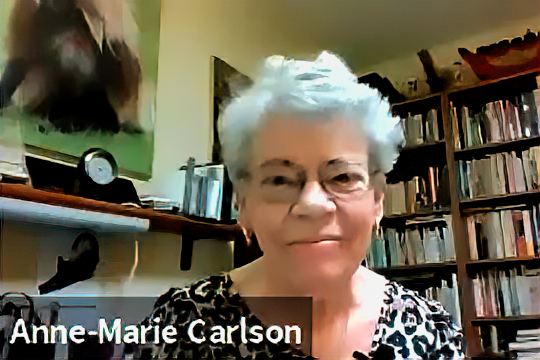
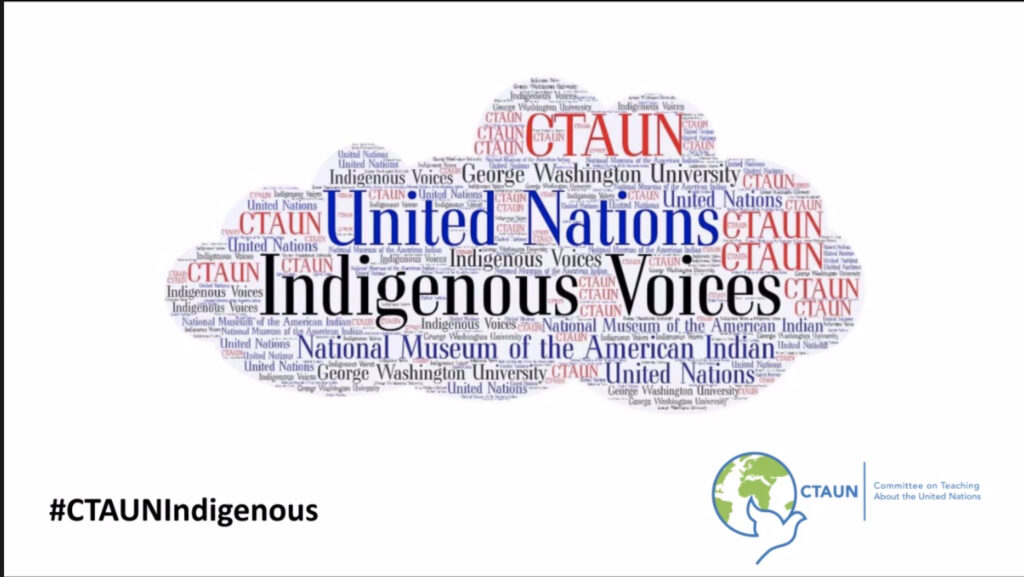
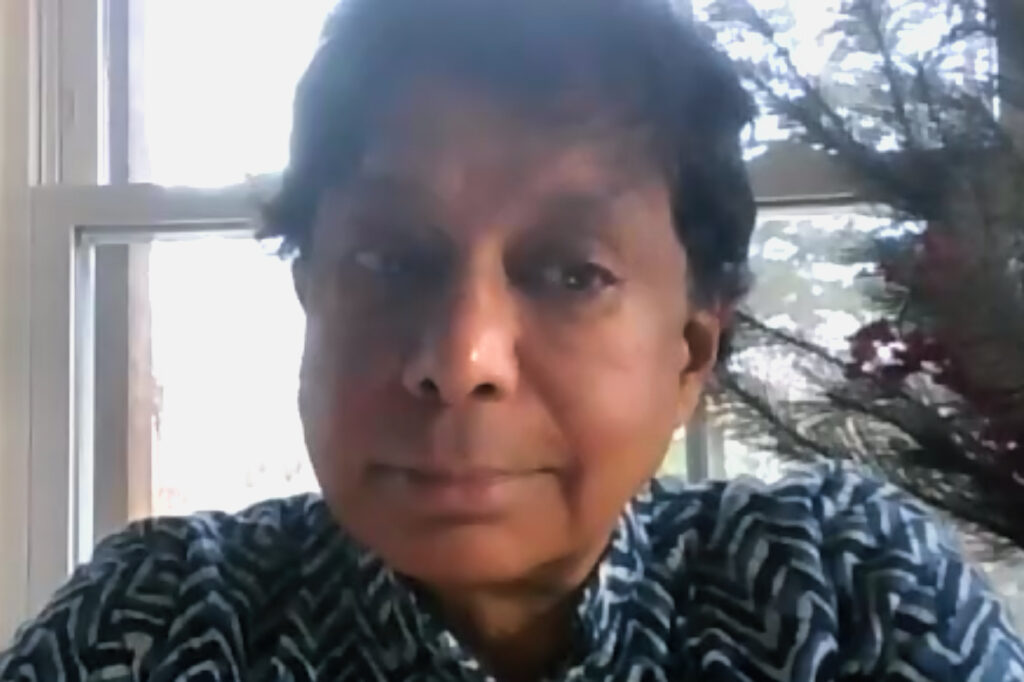
Ramu Damodaran
Ramu Damodaran, Deputy Director for Partnership and Public Engagement in the United Nations Department of Public Information’s Outreach Division, the moderator of the webinar, shared how the United Nations has supported Indigenous Education in different parts of the world and he reflected on the careers and contributions of each speaker. Mr. Damodaran’s reflections during the webinar were sometimes informational, sometimes reflective, and always with grace.
Nina Kantcheva, Senior Policy Adviser UN Development Programme (UNDP) presented the Equator Prize Initiative that ensured respect and recognition for Indigenous Peoples sovereignty and traditional knowledge. For over 10 years communities around the world have received this prize, which comes with an award of $10,000, to sustain their nature-based solutions. The UNDP initiative highlighted that the strength of partnerships with Indigenous Peoples was necessary to protect their lands and to combat climate change.
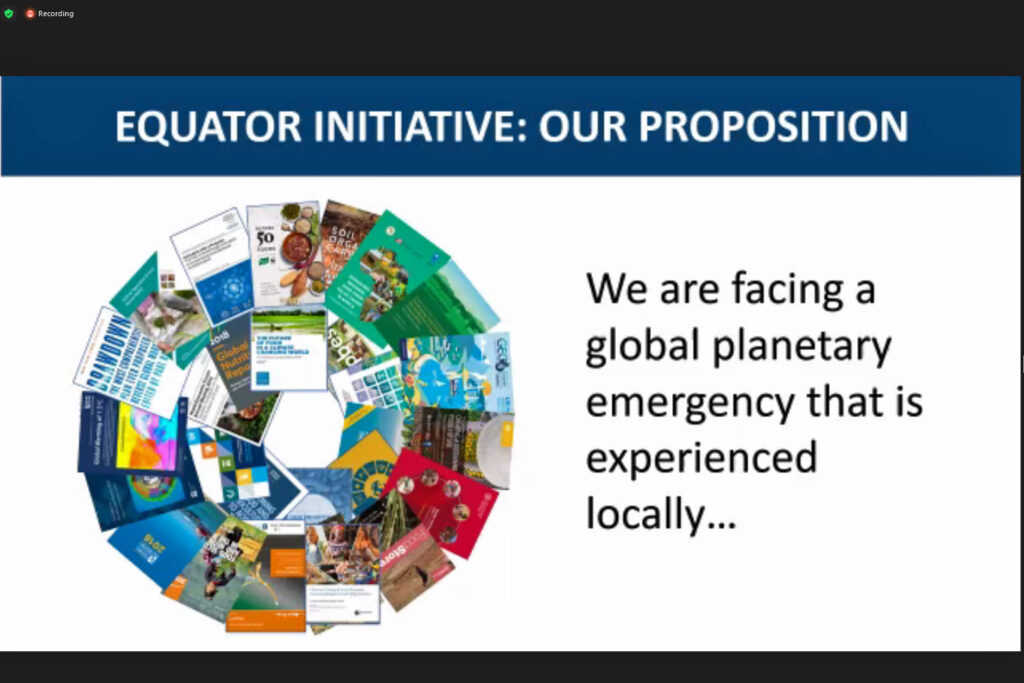
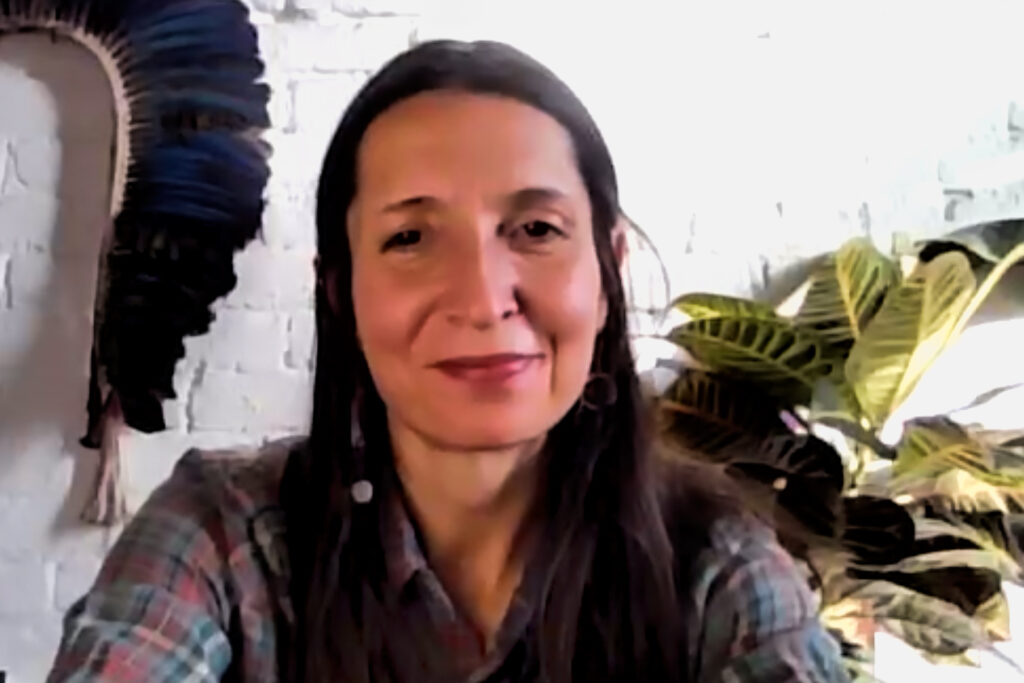
Nina Kantcheva 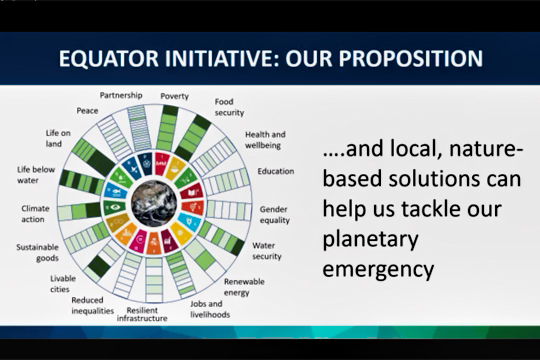
Chief Wilton Littlechild,, Cree Chief and Lawyer--Alberta, Canada and Former Grand Chief of the Confederacy of Treaty Six First Nations and member of Parliament, revealed how the separation from parents, removal of language, and the denial of human rights was slowly reversed with the creation of the United Nations Declaration for the Rights of Indigenous Peoples. Recognition of Indigenous Peoples rights is still a challenge as reconciliation slowly advances. You can watch his slide presentation here:
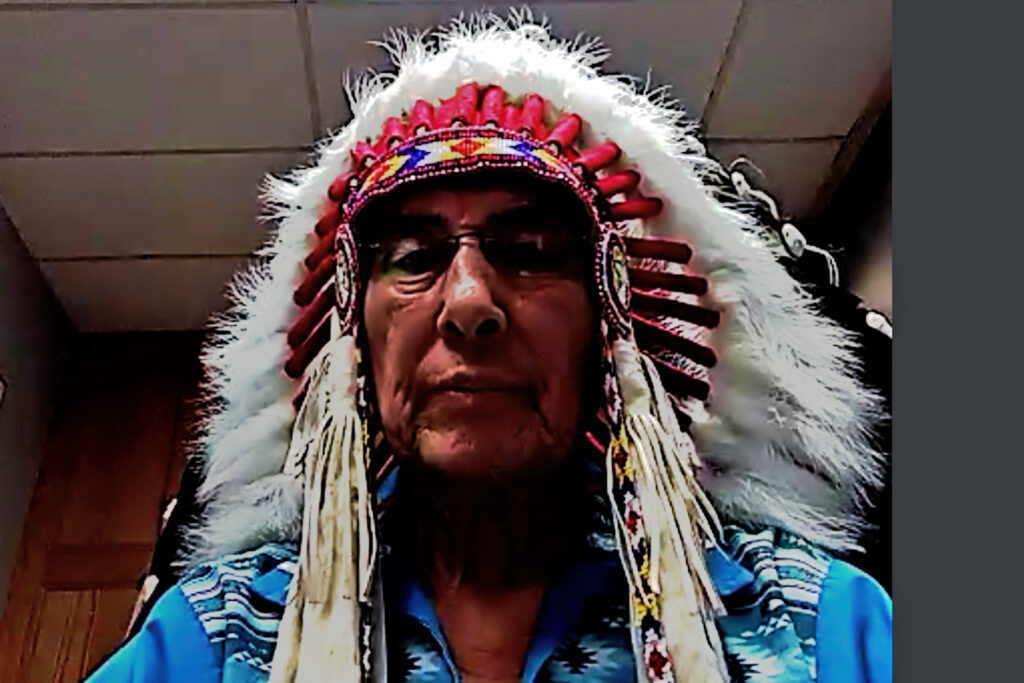
Chief Littlechild 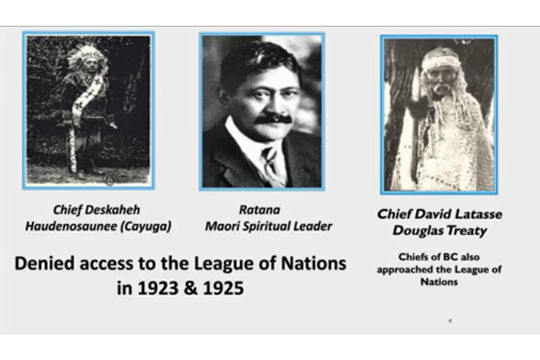
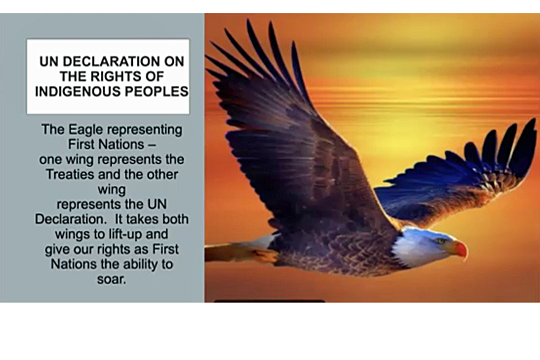
UN Declaration
Dr. Elizabeth Rule, Chickasaw Nation, George Washington University-Professor of Native American Political Leadership Program shared how the GWU program reflected the United Nations vision of bringing communities together and through education ensuring the rights of Indigenous Peoples. Dr. Rule’s innovative program was highlighted by three of her Indigenous students: Allissia Bandin (Tohono O’odham), Ternance Fields (Pawnee), Samantha Harrison (Inupiat). Recognizing these students’ educational journeys shared the impact of Dr. Rule’s innovative program.
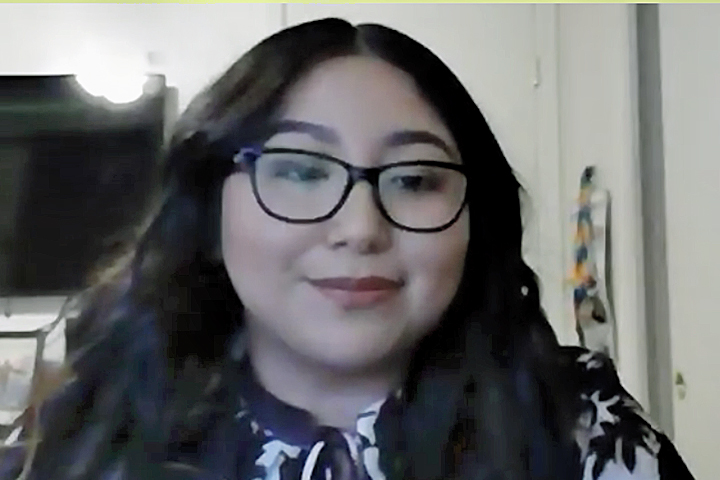
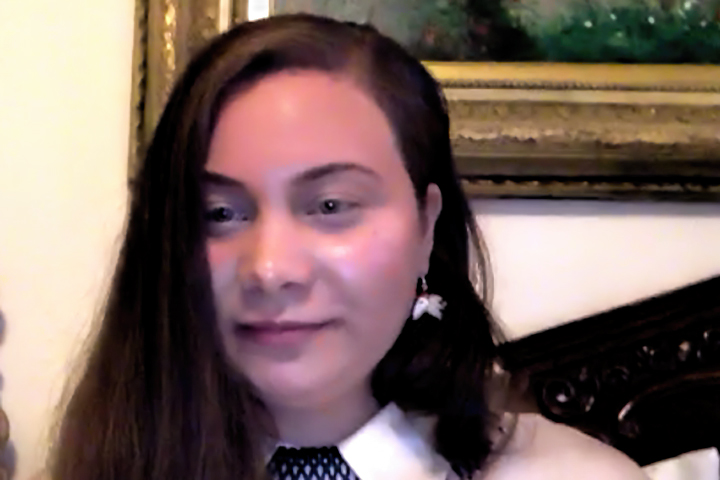
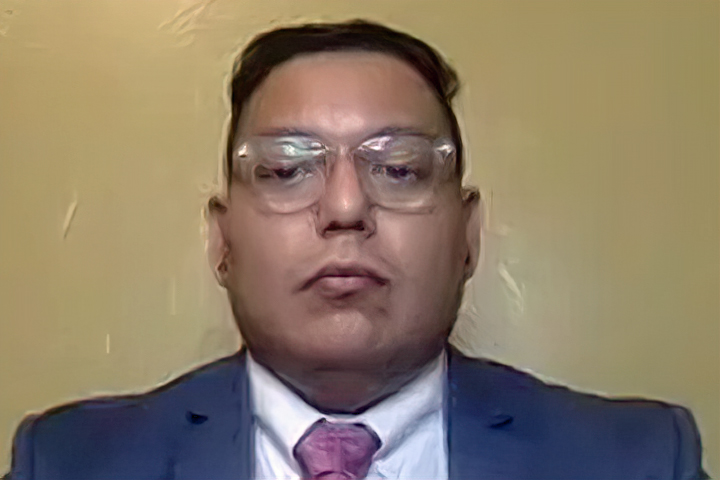
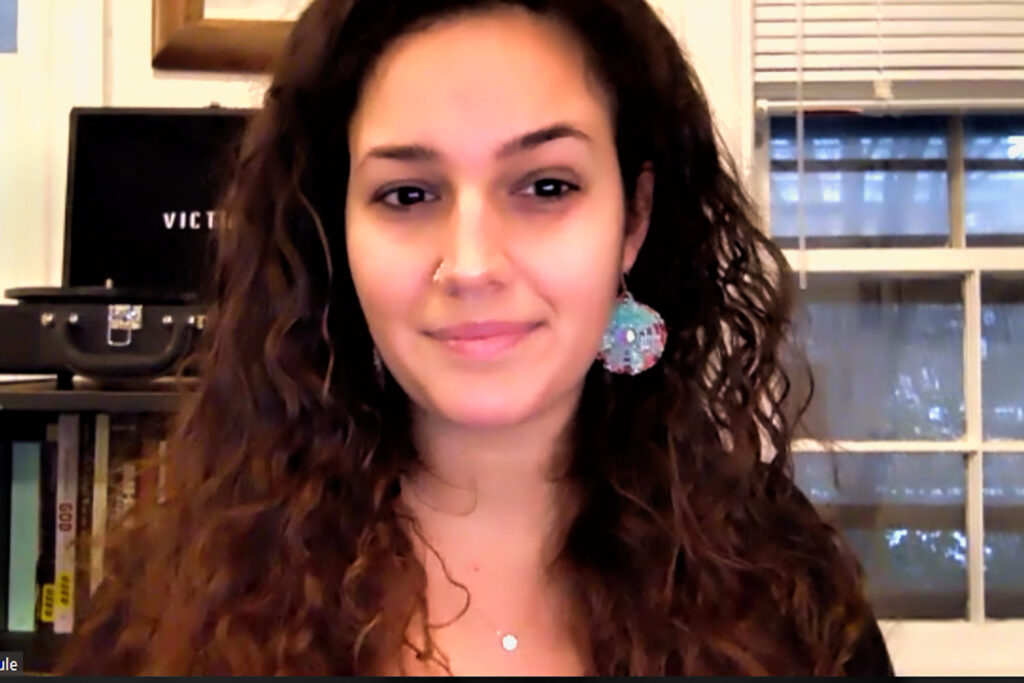
Dr. Elizabeth Rule
Dr. Edwin Schupman, Muscogee Nation,Manager of National Education at the Smithsonian National Museum of the American Indian shared how misconceptions and lack of information in textbooks, media presentations, and political dialogue had denied Indigenous Peoples the recognition and respect they deserved. His innovative NK360 curriculum offered by the National Museum of the American Indian would give teachers valuable resources to reshape the deficient school curriculums that exist, to combat racism, and to celebrate differences.
Questions and Answers Ramu Damodaran directed questions to different speakers. It was at this time that one of the speakers recommended that volunteering was an act of reconciliation to share the ways of Indigenous Peoples.
Anne-Marie Carlson closed the webinar with tributes to the CTAUN team of designers and producers.
Reported by Mary Metzger
A recording of the entire webinar can be found HERE
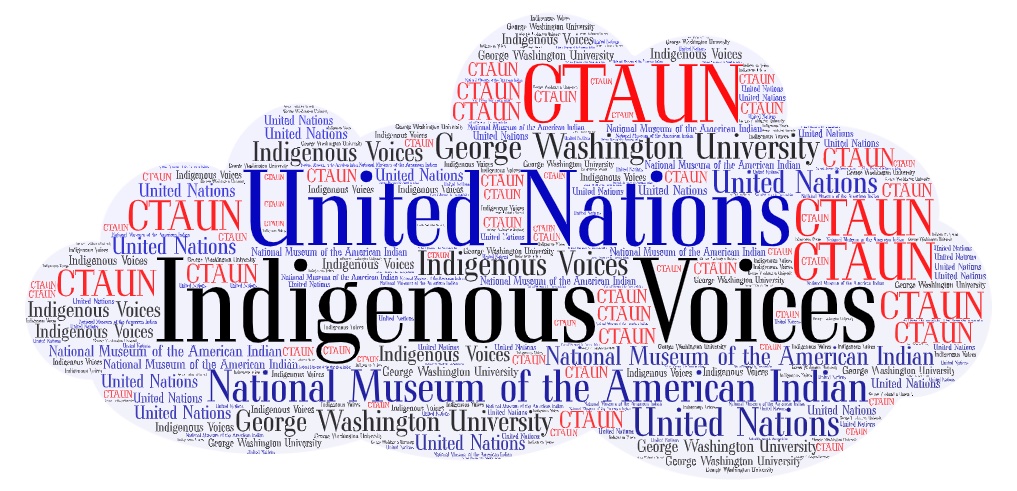
Resources for Educators
1. Reference Resources of Indigenous Peoples at the United Nations
2. Lesson Plans and Activities for Non Indigenous and Indigenous Peoples
3. Reference Resources Related to COVID-19
1. Reference Resources of Indigenous Peoples at the United Nations
| The United Nations Declaration on the Rights of Indigenous Peoples (UNDRIP) was adopted by the General Assembly on Thursday, 13 September 2007, by a majority of 144 states. It establishes a universal framework of minimum standards for the survival, dignity and well being of the indigenous peoples of the world and it elaborates on existing human rights standards and fundamental freedoms as they apply to the specific situation of indigenous peoples. Document United Nations. (March 2008). Declaration on the Rights of Indigenous Peoples (UNDRIP). Retrieved December 25, 2020, from https://www.un.org/esa/socdev/unpfii/documents/DRIPS_en.pdf Video The anniversaries of the adoption of the United Nations Declaration on the Rights of Indigenous People reflected on a variety of achievements and ongoing persistent challenges around the world. “10th Anniversary United Nations Declaration on the Rights of Indigenous Peoples.” YouTube, 28 Nov. 2017, https://youtu.be/yhw5Ko0o5xE “13th Anniversary of the Adoption of the UN Declaration on the Rights of Indigenous Peoples by the United Nations General Assembly and States.” YouTube, 15 Sept 2020, https://www.youtube.com/watch?v=uYy7Ds2szWk |
|
The United Nations Inter-Agency Support Group
(IASG)
on Indigenous Issues strengthens
inter-agency cooperation and coordination within the United Nations system. Website
The
United Nations Permanent Forum on Indigenous Issues (UNPFII) is a
high- level advisory body to the Economic and Social Council. The Forum was
established on 28 July 2000 with the mandate to deal with
indigenous issues related to economic and social development, culture, the
environment, education, health and human rights. Website
Videos
Chairperson Victoria Tauli-Corpuz, United Nations
Permanent Forum official, refers to the interests and concerns of Indigenous
People.
“UNICEF: Securing the
Rights of Indigenous People.” YouTube,
16 April 2009
https://www.youtube.com/watch?v=BVREa0NJAuE
Despite progress to
protect their rights, many of the world’s 370 million indigenous peoples face
discrimination and threats to their livelihoods and ancestral lands.
“Protecting the Rights and Wellbeing of
Indigenous Peoples.” YouTube, Apr
2, 2018, https://www.youtube.com/watch?v=DXz96CvgEy4&feature=youtu.be
The
United Nations Educational, Scientific and Cultural Organization (UNESCO) and the
Education 2030 Agenda bring new impetus to ensure that indigenous peoples’
priorities are heard. The document compiles practical examples related to
indigenous peoples’ right to education, extracted from reports submitted by
Member States. Website
Document
United Nations
Educational, Scientific and Cultural Organization (UNESCO). (2019). Indigenous peoples’ right to education:
overview of the measures supporting the right to education for indigenous
peoples reported by Member States in the context of the ninth Consultation on
the on the 1960 Convention and Recommendation against Discrimination in
Education. Retrieved December 25, 2020, from
https://unesdoc.unesco.org/ark:/48223/pf0000369698
Video Remarks by Ms. Yalitza Aparicio, UNESCO Goodwill Ambassador for Indigenous Peoples, on the conclusion of the 2019 International Year of Indigenous Languages, High-level event, General Assembly. “UNESCO: Yalitza Aparicio on the Conclusion of the 2019 International Year of Indigenous Languages, High Level event, in the United Nations General Assembly.” YouTube, 28 Nov. 2017, http://webtv.un.org/watch/yalitza-aparicio-unesco-on-the-conclusion-of-the-2019-international-year-of-indigenous-languages-high-level-event-general-assembly/6116525318001/ The United Nations Children's Fund (UNICEF) is commitment to support the indigenous children in areas that include, but not limited to: health and nutrition; quality education that ensures their practices and beliefs; effective, culturally sensitive protection and support; and participation in the decisions that affect them. This commitment is anchored in the principles and provisions of the Convention on the Rights of the Child (CRC). Website Document United Nations Children's Fund (UNICEF) Innocenti Research Centre. (October 2003). Innocenti Digest 11 – Ensuring the Rights of Indigenous Children. Retrieved December 25, 2020, from https://www.unicef.org/policyanalysis/rights/files/Indigenous_Digest-Ensuring_Rights_of_Indigenous_Children.pdf Video UNICEF works for the rights of every child, every day, across the globe. “UNICEF: For Every Child.” YouTube, 11 Dec 2016, https://www.youtube.com/watch?v=E1xkXZs0cAQ The United Nations Development Programme (UNDP) is the United Nation’s development agency and plays a critical role in helping countries achieve the Sustainable Development Goals. Website Videos The Equator Initiative brings together the United Nations, governments, civil society, businesses and grassroots organizations to recognize and advance local sustainable development solutions for people, nature and resilient communities. “Equator Prize 2020: Community Statement.” YouTube, Sep 29, 2020, https://youtu.be/7QqneOApcug Equator Prize Award Ceremony, held on 29 September 2020, honored 10 outstanding Indigenous and local groups from 10 countries, each showcasing innovative, nature-based solutions for tackling biodiversity, climate change, development, and poverty challenges. “ Equator Prize 2020: Nature for Life.” YouTube, Oct 9, 2020, https://youtu.be/d_as129DW1U |
|
The
United Nations Declaration on the Rights of Indigenous Peoples (UNDRIP) is
also integrated within operational activities and programs at the country
level, affecting the lives of all indigenous peoples.
Document
United
Nations. (2009). The United Nations
Development Group’s Guidelines on Indigenous Peoples’ Issues. Retrieved
December 25, 2020, from
https://unsdg.un.org/resources/united-nations-development-groups-guidelines-indigenous-peoples-issues
Videos
Nemonte
shares her clarity of purpose, as president of the Waorani of Pastaza and a
co-founder of the Ceibo Alliance. She protects the Waorani’s ancestral home
in Ecuador from immediate destruction.
“Nemonte Nenquimo, Time
List 2020.” YouTube, Sep 25,
2020, https://youtu.be/L42ZY_wmscM Edwin Shupman refers to the American Indian Responses to Environmental Challenges as an interactive educational resource that teaches how four Native nations are addressing environmental issues in their homelands. “Teach In 2020: American Indian Response to Environmental Challenges.”YouTube, Oct 9, 2020, https://www.youtube.com/watch?v=AUrI3DRYi6w&feature=youtu.be Winona LaDuke LaDuke (member of the Mississippi Band Anishinaabeg of the White Earth reservation) is an internationally known activist working on issues of sustainable development, renewable energy, and food systems. “Teach In 2020 Keynote—Winona LaDuke: Water and Food Justice.”YouTube, Oct 9, 2020, https://www.youtube.com/watch?v=lVbi-W0Z7T8&feature=youtu.be In 1882 the Danish researcher and teacher Sophus Tromholt travelled to Northern Norway took photographs of the native inhabitants of the Sápmi area, formerly known as Lapland. “People of the Sapmi: Northern Norway.” YouTube, Apr 28, 2018, https://youtu.be/ya6yw7RPjGg Tara Houska is a tribal rights attorney in Washington DC. She’s also former Director at Honor the Earth, the indigenous environmental justice group. Tara is of Couchiching First Nation, bear clan, and in late 2016, she called Morton County North Dakota home for six months. “Tara Houska: The Last Holders." YouTube, 1 Aug 2019, https://youtu.be/4J7qxGJV_Og An introduction to the Sami history, culture and language. “My People: The Sami People.” YouTube, 29 May 2013, https://www.youtube.com/watch?v=ZZIU7KEis3w&feature=youtu.be |
2. Education Resources of Non Indigenous and Indigenous Peoples
The educational resources are a sample from different countries around the world, including: Australia, Canada, New Zealand, and the United States of America. By using or adapting the core lessons and activities, your students may address essential questions regarding indigenous people. For example, New Zealand has already established the sustainable Action Plan for Pacific Education 2020-2030 to recover from COVID-19 pandemic.
Australia
| Grade: Foundation – Year 10 Subject: Science Title: Australian Curriculum: Science Aboriginal and Torres Strait Islander Histories and Cultures Cross-Curriculum Priority Description: Aboriginal Peoples and Torres Strait islander Peoples have worked scientifically for millennia and continue to contribute to contemporary science and provide the opportunity to embed a uniquely Australian perspective into the Science curriculum. Resource: Australian Curriculum, Assessment and Reporting Authority (ACARA). (November 2019). Australian Curriculum: Science Aboriginal and Torres Strait Islander Histories and Cultures Cross-Curriculum Priority. Content elaborations and teacher background information for Foundation to Year 6. Retrieved December 25, 2020, from https://www.australiancurriculum.edu.au/media/5653/ccp-tbi-f-6-ver5-online.pdf Australian Curriculum, Assessment and Reporting Authority (ACARA). (November 2019). Australian Curriculum: Science Aboriginal and Torres Strait Islander Histories and Cultures Cross-Curriculum Priority. Content elaborations and teacher background information for Years 7-10. Retrieved December 25, 2020, from https://www.australiancurriculum.edu.au/media/5157/ccp-tbi-7-10.pdf |
Canada
| Grade: K-10 Subject: Title: Shared Learnings: Integrating BC Aboriginal Content K-10 Description: The resource focuses on the diversity, depth, and integrity of the cultures of British Columbia Indigenous peoples. The curriculum helps teachers bring Indigenous knowledge into the classroom in a way that is accurate, and gives Indigenous students a sense of place and belonging in the public school system. Resource: Aboriginal Education Enhancements Branch, British Columbia Ministry of Education. (2006). Shared Learnings: Integrating BC Aboriginal Content K-10. Retrieved December 25, 2020, from https://www2.gov.bc.ca/assets/gov/education/kindergarten-to-grade-12/teach/teaching-tools/aboriginal-education/shared_learning.pdf |
| Grade: K-12 Subject: All Title: British Columbia: Indigenous Knowledge and Perspectives in K-12 Curriculum Description: These documents reflect implicit and explicit references to Indigenous Knowledge and Perspectives throughout the K-12 Curriculum. Educators may use this resource to easily access where Indigenous Knowledge and Perspectives intersect with the curriculum in every area of learning at every grade level. Now, with the education transformation, there is an attempt to incorporated Indigenous perspectives into all parts of the curriculum in a meaningful and authentic manner. Resource: Ministry of Education, Government of British Columbia. (October 5, 2020).Indigenous Knowledge and Perspectives in K-12 Curriculum. Retrieved December 25, 2020, from https://curriculum.gov.bc.ca/curriculum/indigenous-education-resources/indigenous-knowledge-and-perspectives-k-12-curriculum |
| Grade: 6 Subject: Meaningful Reconciliation Title: What Can I Contribute to Meaningful Reconciliation? Teaching and learning about residential schools. Description: Reconciliation is both an individual journey as well as a collective journey. Our hope is that this resource will support our students in learning the history present within our community, create intercultural understanding of our complex communities, and help build the unknown future ahead. Resource: The Critical Thinking Consortium. (n.d.).What Can I Contribute to Meaningful Reconciliation? Teaching and learning about residential schools. Retrieved December 25, 2020, from https://tc2.ca/uploads/PDFs/reconciliation/meaningful_reconciliation.pdf |
New Zealand
| Grade: Y1-Y13 Subject: All Title: The New Zealand Curriculum Description: The New Zealand Curriculum is a statement of official policy relating to teaching and learning in English-medium New Zealand schools. A parallel document, Te Marautanga o Aotearoa, serves the same function for Māori-medium schools. Although they come from different perspectives, both give effect to the partnership that is at the core of our nation’s founding document, Te Tiriti o Waitangi / the Treaty of Waitangi. Resources: Ministry of Education of New Zealand. (2015). The New Zealand Curriculum. Retrieved December 25, 2020, from file:///Users/macuser/Downloads/NZ%20Curriculum%20Web-1.pdf Ministry of Education of New Zealand. (2017). Te Marautanga o Aotearoa. Retrieved December 25, 2020, from file:///Users/macuser/Downloads/Te%20Marautanga%20o%20Aotearoa%202017.pdf |
| Grade: Early childhood education, schooling system, tertiary education institutions Subject: All Title: Action Plan for Pacific Education 2020-2030 Description: The Action Plan’s release coincides with a world changed by the COVID-19 pandemic. The vision for this Action Plan is ‘diverse Pacific learners and families are safe, valued and equipped to achieve their education aspirations’. This was developed following a series of conversations across New Zealand with Pacific learners, families and communities. Resource: Ministry of Education of New Zealand. (July, 2020). Action Plan for Pacific Education 2020-2030. Retrieved December 25, 2020, from file:///Users/macuser/Downloads/The-New-Zealand-Curriculum.pdf |
United States of America
| Grade: Pre K-13+ Subject: All Title: Native Knowledge 360° Essential Understandings about American Indians Description: The National Museum of the American Indian (NMAI) Native Knowledge 360° Essential Understandings about American Indians is a framework that offers new possibilities for creating student learning experiences. Building on the ten themes of the National Council for the Social Studies' national curriculum standards, the NMAI's Essential Understandings reveal key concepts about the rich and diverse cultures, histories, and contemporary lives of Native peoples. Resource: The National Museum of the American Indian (NMAI). (n.d.). Native Knowledge 360° Essential Understandings about American Indians. Retrieved December 25, 2020, from https://americanindian.si.edu/nk360/lessons-resources/search-resources |
| Grade: K-12 Subject: Science Title: A Handbook for Culturally Responsive Science Curriculum Description: For many Indigenous educators, a culturally responsive science curriculum has to do with their passion for making cultural knowledge, language and values a prominent part of the schooling system. For non-Indigenous educators, a culturally responsive science curriculum has more to do with adjusting teaching strategies to make a place for such knowledge, and coming to value a new perspective. It too has to do with addressing science standards and finding the knowledge, strategies, and support needed to carry out this work together. Resource: Alaska Native Knowledge Network, Alaska Rural Systemic Initiative (AKRSI), and the Alaska Department of Education (2000). A Handbook for Culturally Responsive Science Curriculum. Retrieved December 25, 2020, from http://www.ankn.uaf.edu/publications/handbook/handbook.pdf |
| Grade: Elementary, Middle School, High School Subject: Language Title: Rising Voices/Hótȟaŋiŋpi: Learning the Lakota Language Description: The study guide has activities for teachers of classes in schools where Lakota is not taught, but also many exercises for teachers in schools that do have required Lakota language classes. The teacher’s guide has three main sections: Comprehension exercises, expansion activities, and Lakota language exercises. Resource: Rising Voices/Hótȟaŋiŋpi. (2020). Study Guide. Retrieved December 25, 2020, from https://risingvoicesfilm.com/learning-the-lakota-language/study-guide/ |
| Grade: Elementary, Middle School, High School Subject: Music Title: Smithsonian Folkways Recordings – Indigenous People in the World Description: Smithsonian Folkways Recordings is the nonprofit record label of the Smithsonian Institution, the national museum of the United States. The organization is dedicated to supporting cultural diversity and increased understanding among peoples through the documentation, preservation, and dissemination of sound. Resource: Smithsonian Institution. (2020). Folkways Recording. https://folkways.si.edu |
| Grade: K-2 Subject: History Title: Shawnee: Who We Are Yesterday and Today Description: Students will explore various components of identity within the context of the Piqua Shawnee Nation of Alabama, the Shawnee Nation prior to contact, and various Shawnee tribes across the United States. Students will explore what identity means from a personal individual and collective level, and relate various components of identity to indigenous peoples. Students will analyze various primary and secondary sources to understand in a deeper way the identity of the Piqua Shawnee Nation today. Students will collaborate with tribal members and classrooms across the state and nation, as well as their peers, in exploring the identity of this nation. Through purposeful research, reflection, and collaboration, students will shatter their own misconceptions about indigenous peoples while creating ways to education their community regarding the rich identity of the Shawnee Nation today. Resource: University of Massachusetts Amherst, Smith College, and Aquinnah Cultural Center. (n.d.).Teaching Native American Histories. Shawnee: Who We Are Yesterday and Today. Retrieved December 25, 2020, from https://teachnativehistories.umass.edu/shawnee-who-we-are-yesterday-and-today |
| Grade: K-2 Subject: History Title: We Are Still Here: An Introduction to Native American Communities in Southern New England Description: These lessons will be taught near the beginning of a semester long study of Native Americans in Southern New England. Students will be introduced to some of the tribal nations in Southern New England, including Wampanoag, Narragansett, Niantic, Nipmuc and Mohegan. By examining and discussing photographs and images on their tribal websites an other social media, students will have the opportunity to reconsider many preconceptions they may have about Native Americans today. Students will learn about Strawberry Thanksgiving using the children's book Strawberry Thanksgiving written by Paulla Dove Jennings (Niantic and Narragansett) and illustrated by Ramona Peters (Mashpee Wampanoag). These lessons will serve as a reference point throughout the study as we consider aspects of culture and tradition in contemporary native communities. Resource: University of Massachusetts Amherst, Smith College, and Aquinnah Cultural Center. (n.d.).Teaching Native American Histories. We Are Still Here: An Introduction to Native American Communities in Southern New England. Retrieved December 25, 2020, from https://teachnativehistories.umass.edu/we-are-still-here-introduction-native-american-communities-southern-new-england |
| Grade: K-2 Subject: History Title: Stories We Use to Understand Our World: Exploring Native American Deeptime Stories and Geology Explanations Description: In this unit, 2nd grade students will explore two ways that we tell stories in order to explain the world around us. By focusing on a mountain that is (just about!) visible from the school, students will connect with the cultural importance of deep-time stories as a way to understand our landscape. This will be compared to a geological explanation of mountains. Students will engage in multiple ways with both types of stories--through listening, analyzing, illustrating, telling (the story), and comparing. A collaboration between the classroom and library, this unit includes extension activities in the art classroom and sets the stage for a connected writing project. Students engage with local native culture and history and are encouraged to nurture a deeper respect for traditional tales. A “Read and Analyze Nonfiction Chart” is used to scaffold a mini-research process, allowing students to confirm their prior knowledge and uncover misconceptions. Resource: University of Massachusetts Amherst, Smith College, and Aquinnah Cultural Center. (n.d.).Teaching Native American Histories. Stories We Use to Understand Our World: Exploring Native American Deeptime Stories and Geology Explanations. Retrieved December 25, 2020, from https://teachnativehistories.umass.edu/stories-we-use-understand-our-world-exploring-native-american-deeptime-stories-and-geology |
| Grade: K-2 Subject: Language Arts and History Title: People of the First Light Description: Students compare and contrast traditional to contemporary cultures and languages of Native Americans from the Wampanoag tribe using primary and secondary sources. Students compare and organize daily life and responsibilities of family members, identify forms of sustenance, horticulture, and special occasions, discuss self-identity through kinship and clans of the Wampanoag people. Students critique and find similarities of oral traditions and folklores used for culture teachings, explore how Native American names, labels, or phrases are used worldwide, and analyze their own language to identify factors that lead to language loss and the effects of the loss. Resource: University of Massachusetts Amherst, Smith College, and Aquinnah Cultural Center. (n.d.). Teaching Native American Histories. People of the First Light. Retrieved December 25, 2020, from https://teachnativehistories.umass.edu/people-first-light |
| Grade: K-2 Subject: History Title: Indian People Still Exist: Bridging the Knowledge-Gap That May Persist Among Elementary School Children to Show the Continuous Link between 17th Century Patuxet Wampanoag to Present-Day Wampanoag Description: During a fall unit within the Second Grade “Journeys” social studies curriculum, students focus on the 1620/21“encounter,” exploring the differences between aspects of daily life of the English and Wampanoag People, as well as the story about [according to current scholarship] their encounter and subsequent “Harvest Feast”. The following unit addresses the fact that although many of the Wampanoag traditions have been absorbed into mainstream society and even disappeared, some have been maintained. The Wampanoag project to revitalize their language is a concrete and meaningful example of how not only do “Indians still exist today,” but that aspects of their culture still live on. This will be addressed in light of the fact that all cultures, including those with which the students identify, evolve in order to survive throughout technological and other influences over time. Resource: University of Massachusetts Amherst, Smith College, and Aquinnah Cultural Center. (n.d.). Teaching Native American Histories. Indian People Still Exist: Bridging the Knowledge-Gap That May Persist Among Elementary School Children to Show the Continuous Link between 17th Century Patuxet Wampanoag to Present-Day Wampanoag. Retrieved December 25, 2020, from https://teachnativehistories.umass.edu/indian-people-still-exist-bridging-knowledge-gap-may-persist-among-elementary-school-children-show |
| Grade: K-5 Subject: U.S. History, Painting, Dance Title: Language of Place: Hopi Place Names, Poetry, Traditional Dance and Song Description: This is a three-lesson ELA curriculum unit, which guides students’ exploration of Hopi language forms in order to help them to understand the Hopi’s centuries-old relationship with the land and the process of growing corn. Lesson 1 uncovers the Hopi homeland through maps and place names. Students examine regional place names of their own home communities and create personal maps;Lesson 2 involves a close study of contemporary Hopi poet, Ramson Lomatewama. Students analyze how Lomatewama’s uses figurative language to describe his intimate relationship with the land;Lesson 3 pursues corn as a symbol manifested in Hopi song and traditional dances. Students analyze examples of these in order to expand their cultural awareness. Resource: National Endowment for the Humanities (NEH). (n.d.). Edsitement! The Best of Humanities on the Web. Language of Place: Hopi Place Names, Poetry, Traditional Dance and Song. Retrieved December 25, 2020, from https://edsitement.neh.gov/curricula/language-place-hopi-place-names-poetry-traditional-dance-and-song |
| Grade: 3-5 Subject: Language Arts and History Title: Picture This: An interactive read aloud of 1621: A New Look At Thanksgiving Description: In this lesson, students will sketch what they think the first Thanksgiving looked like, and they will share their sketches and thinking with a nearby partner. Following this, they will participate in an interactive read aloud of 1621, A New Look at Thanksgiving, where they will listen to the story, analyze the pictures, and answer and discuss document based questions that are geared to enhance their understanding of the First Thanksgiving. After the story is read, students will again sketch what they think the first Thanksgiving looked like and compare their sketches. The hope is the new and accurate information from the book will alleviate stereotypes based off of perpetuated misinformation. Resource: University of Massachusetts Amherst, Smith College, and Aquinnah Cultural Center. (n.d.).Teaching Native American Histories. Picture This: An interactive read aloud of 1621: A New Look At Thanksgiving. Retrieved December 25, 2020, from https://teachnativehistories.umass.edu/picture-interactive-read-aloud-1621-new-look-thanksgiving |
| Grade: 3-5 Subject: Language Arts and History Title: Water and Life: An Introduction to the Lands of the Wampanoag Description: Our students have a relationship with land and water. As humans we have a relationship with the land and water. What does that relationship look like? Students will reflect on their connection with water as they begin to learn about the cultural identity of the Wampanoag Nation through the reading of primary and secondary Wampanoag sources. Resource: University of Massachusetts Amherst, Smith College, and Aquinnah Cultural Center. (n.d.).Teaching Native American Histories. Water and Life: An Introduction to the Lands of the Wampanoag. Retrieved December 25, 2020, from https://teachnativehistories.umass.edu/water-and-life-introduction-lands-wampanoag |
| Grade: 3-5 Subject: Language Arts and History Title: First Contact Mini-Unit Description: This mini-unit will give students a deeper understanding of the impact of Colonization on the Native Peoples of the New England area. Students will- understand that Native Americans exist in the present, be able to explain the differences of land usage between the English and the Native population, and understand how Colonization affected/decimated the Native population. Bonus objective- students will understand how the Wampanoag tribe is reclaiming their language through linguistics, language programs, and research. Resource: University of Massachusetts Amherst, Smith College, and Aquinnah Cultural Center. (n.d.).Teaching Native American Histories. First Contact Mini-Unit. Retrieved December 25, 2020, from https://teachnativehistories.umass.edu/first-contact-mini-unit |
| Grade: 3-5 Subject: Language Arts and History Title: New Encounters: Asking Questions and Inferring Motive from Prime Sources Description: In this three-day lesson, 3rd-Graders will be guided through a primary source describing an encounter between California Coast Miwok and the English privateer Sir Francis Drake. Starting with a roleplaying activity (Alien Greeting Game), students will experience and reflect on the confusion that can occur when people from different cultures meet for the first time. Then, through excerpts from the journal of Frances Fletcher, the chaplain aboard the Golden Hind, students will develop a list of research questions. The lesson ends with a connection to the Doctrine of Discipline, which reveals the true motive of Sir Francis Drake and other European colonizers. Please note that this three-day lesson takes place in the middle of a unit on Coast Miwok, so the students already have some familiarity with the topic. Resource: University of Massachusetts Amherst, Smith College, and Aquinnah Cultural Center. (n.d.).Teaching Native American Histories. New Encounters: Asking Questions and Inferring Motive from Prime Sources. Retrieved December 25, 2020, from https://teachnativehistories.umass.edu/new-encounters-asking-questions-and-inferring-motive-prime-sources |
| Grade: 3-5 Subject: Language Arts and History Title: Elder Interview Project Description: Fourth grade students will interview elders from the Wampanoag and Mohican Nations. They will first learn how the interview process works, and practice interviewing their peers. Students will learn about the history of the Wampanoag and Mohican Nations so they will have needed background information on the Nations being represented by the elders they will be interviewing. Students will develop questions in advance of each interview. These will be sent in advance to the elder who will be visiting the classroom. On the day of each interview, students will each receive a printed question sheet with space to record their answers. The elder will be introduced, and then the interview will begin. In the next lesson, the students will each create a project to summarize and reflect on what they have learned. In the last lesson, students will give an oral reflection to their class. Resource: University of Massachusetts Amherst, Smith College, and Aquinnah Cultural Center. (n.d.).Teaching Native American Histories. Elder Interview Project. Retrieved December 25, 2020, from https://teachnativehistories.umass.edu/elder-interview-project |
| Grade: 3-5 Subject: Language Arts and History Title: California’s Unratified Treaties Description: Students will learn about and read California’s unratified treaties with the Native nations of the state; students will map the promised land areas and write about how the state would be different had the treaties been ratified and honored. Students will finish by learning about modern Native efforts to reclaim land in their local area. Resource: University of Massachusetts Amherst, Smith College, and Aquinnah Cultural Center. (n.d.).Teaching Native American Histories. California’s Unratified Treaties. Retrieved December 25, 2020, from https://teachnativehistories.umass.edu/california%E2%80%99s-unratified-treaties |
| Grade: 3-5 Subject: Language Arts and History Title: Enrichment Unit: Understanding Indigenous Historical Trauma Via a Short, Middle Grade Novel, Fatty Legs: A True Story Description: By reading the fictionalized memoir account of Canadian boarding school survivor Margaret Pokiak-Fenton (Inuvialuit) in the short, middle-grade novel Fatty Legs: A True Story and primary source documents, students can explore topics related to the Doctrine of Discovery, colonization, boarding schools, historical and generational trauma of Indigenous Peoples, and Indigenous resistance. Students can be directly taught to look through a lens of empathy to understand both the unfairness Margaret Pokiak-Fenton experienced as well as the remarkable strengths that she, and many survivors like her, drew on to resist acculturation and endure. This collection of lessons assumes students have very little understanding of present day Indigenous Peoples. Students show learning in two final projects about boarding schools and their effects: 1) Compassionate Understanding of a Survivor’s Experience and 2) Historical Trauma and Resilient Survivance. Resource: University of Massachusetts Amherst, Smith College, and Aquinnah Cultural Center. (n.d.).Teaching Native American Histories. Enrichment Unit: Understanding Indigenous Historical Trauma Via a Short, Middle Grade Novel, Fatty Legs: A True Story. Retrieved December 25, 2020, from https://teachnativehistories.umass.edu/enrichment-unit-understanding-indigenous-historical-trauma-short-middle-grade-novel-fatty-legs-true |
| Grade: 3-5 Subject: Language Arts and History Title: Understanding Ourselves through Objects! Description: Students bring in objects to share with their classmates and then write paragraphs describing objects that are important to them and their culture(s). This project culminates with a publishing party, followed by a discussion encouraging students to consider how. Resource: University of Massachusetts Amherst, Smith College, and Aquinnah Cultural Center. (n.d.).Teaching Native American Histories. Understanding Ourselves through Objects! Retrieved December 25, 2020, from https://teachnativehistories.umass.edu/understanding-ourselves-through-objects |
| Grade: 3-5 Subject: Language Arts and History Title: Native Americans in New England Curricular Project Description: This lesson sequence introduces students to the idea of Place. Its focus is on building the language related to the substantive topic of the peoples’ relationship with Place. We look at a region as a place in which people needed to adapt and invent ways to acquire their needs from the environment – food, water, shelter, and companionship. Students will develop their background knowledge of Native people of the Northeast region through video, photographs, and picture books that focus on the Wampanoag people. Resource: University of Massachusetts Amherst, Smith College, and Aquinnah Cultural Center. (n.d.).Teaching Native American Histories. Native Americans in New England Curricular Project. Retrieved December 25, 2020, from https://teachnativehistories.umass.edu/native-americans-new-england-curricular-project |
| Grade: 3-5 Subject: Language Arts and History Title: Wampanoags Past and Present Description: Grade 3 students will develop handmade books that focus on 3 different time periods in the history of the Wampanoag Indians of Massachusetts (Mashpee on Cape Cod and Aquinnah/Gay Head on the island of Martha’s Vineyard). (Pre-contact, post-contact and present day.) In session 1, students will create a pre-test drawing that shows what they know, at present, about the Wampanoag people. In sessions 2, 3, and 4 students will view videos about the transportation, shelter and currency used by the Wampanaog Indians as well as using information from class discussions to create drawings that illustrate what they have learned. The primary goal is to have students evaluate the dissonant elements of their beliefs as they create their handmade books so that they can alter their preconceived thoughts about Wampanoag people and replace the incorrect beliefs with accurate information relating to the past and present. Resource: University of Massachusetts Amherst, Smith College, and Aquinnah Cultural Center. (n.d.).Teaching Native American Histories. Wampanoags Past and Present. Retrieved December 25, 2020, from https://teachnativehistories.umass.edu/wampanoags-past-and-present |
| Grade: 3-5 Subject: Language Arts and History Title: A Broader View of the History of Thanksgiving Description: These lessons are designed for intermediate level ELL students in Grade 3 for a small group setting. Joseph Bruchac conceived them to supplement reading lessons using the biography Squanto’s Journey. Students will begin this unit by sharing their existing understandings and common myths about the U. S. Thanksgiving holiday. Students will view a video clip of a contemporary Wampanoag Day of Mourning on Thanksgiving. Students will be introduced to Wampanoag history during the growth of colonization as well as gain awareness of contemporary Wampanoag life in MA. They will engage with primary and secondary sources and make inferences to construct historical understanding about Wampanoag and Pilgrim life during the 1620s. Students will consider the perspectives of Wampanoag and English characters as they make story boards that re-tell the story of events leading up to the “first Thanksgiving. Resource: University of Massachusetts Amherst, Smith College, and Aquinnah Cultural Center. (n.d.).Teaching Native American Histories. A Broader View of the History of Thanksgiving. Retrieved December 25, 2020, from https://teachnativehistories.umass.edu/broader-view-history-thanksgiving |
| Grade: 6-8 Subject: U.S. History Title: Native American Cultures Across the U.S. Description: Children's literature, movies, and other media often perpetuate generalized stereotypes, whether positive or negative, in their representations of Native American peoples. Teaching children about the First Americans in an accurate historical context while emphasizing their continuing presence and influence within the United States is important for developing a national and individual respect for the diverse American Indian peoples, and is necessary to understanding the history of this country. Resource: National Endowment for the Humanities (NEH). (n.d.). Edsitement! The Best of Humanities on the Web. Native American Cultures Across the U.S.Retrieved December 25, 2020, from https://edsitement.neh.gov/lesson-plans/native-american-cultures-across-us |
| Grade: 6-8 Subject: Language Arts and History Title: Decolonize your mind; Re-examine Native Narratives in History Description: Students in our area of Northeastern Pennsylvania (modern-day Pocono Mountains region along the Delaware River) will learn how the indigenous communities that lived in our area still influence the land around us today and that they have shaped our state and have been shaped by our state. Resource: University of Massachusetts Amherst, Smith College, and Aquinnah Cultural Center. (n.d.).Teaching Native American Histories. Decolonize your mind; Re-examine Native Narratives in History. Retrieved December 25, 2020, from https://teachnativehistories.umass.edu/decolonize-your-mind-re-examine-native-narratives-history |
| Grade: 6-8 Subject: Language Arts and History Title: Manifest Destiny and the Doctrine of Discovery Description: Students in our area of Northeastern Pennsylvania (modern-day Pocono Mountains region along the Delaware River) will learn how the indigenous communities that lived in our area still influence the land around us today and that they have shaped our state and have been shaped by our state. Resource: University of Massachusetts Amherst, Smith College, and Aquinnah Cultural Center. (n.d.).Teaching Native American Histories. Manifest Destiny and the Doctrine of Discovery. Retrieved December 25, 2020, from https://teachnativehistories.umass.edu/manifest-destiny-and-doctrine-discovery |
| Grade: 6-8 Subject: Language Arts and History Title: You’re Telling Me the Thanksgiving Story is a Lie? How Do You Know That? Description: Students in our area of Northeastern Pennsylvania (modern-day Pocono Mountains region along the Delaware River) will learn how the indigenous communities that lived in our area still influence the land around us today and that they have shaped our state and have been shaped by our state. Resource: University of Massachusetts Amherst, Smith College, and Aquinnah Cultural Center. (n.d.).Teaching Native American Histories. You’re Telling Me the Thanksgiving Story is a Lie? How Do You Know That?Retrieved December 25, 2020, from https://teachnativehistories.umass.edu/you%E2%80%99re-telling-me-thanksgiving-story-lie-how-do-you-know |
| Grade: 6-8 Subject: Language Arts and History Title: The Debate on the Iroquois’ Influence on the U.S. Constitution Description: The creation of the U.S. Constitution was considered revolutionary and unprecedented for the 18th century. The Founding Fathers have been cited to pull inspiration from ancient Greeks and prior European thought, however, the influence stopped there. Counter to the colonial mindset conscious, recent scholars have sought to prove that the Iroquois influenced the creation of the U.S. government by namely comparing their Great Law of Peace to the Constitution. Other historians refute that assertion. This lesson asks students to not simply argue whether or not the Iroquois influenced the Founding Fathers, but rather why would someone choose to refute or confirm the influence? This serves as a gateway to a discussion on historical trauma by illuminating how Americans have denied, discredited, or even erased the contributions of indigenous nations to the United States. Resource: University of Massachusetts Amherst, Smith College, and Aquinnah Cultural Center. (n.d.).Teaching Native American Histories. The Debate on the Iroquois’ Influence on the U.S. Constitution. Retrieved December 25, 2020, from https://teachnativehistories.umass.edu/debate-iroquois%E2%80%99-influence-us-constitution |
| Grade: 6-8 Subject: Language Arts and History Title: Our Story, Our History: A Reimagining Through Poetry and Primary Source Description: This middle school project is a re-examination of the traditional Thanksgiving story in several parts. First, students are asked to activate prior knowledge as the whole class writes a version of the Thanksgiving story. Students will then research and collect facts on English Settler and Wampanoag lifeways, including analysis of primary source documents. Web resources and a booklist are included in these materials. From their research, students will write summary paragraphs on the two cultures and an opinion paragraph wherein the student chooses to live in one culture. Templates and organizers included in the project handout help students to build a three-paragraph essay. Finally, students will turn research into poetry when they choose an English or Wampanoag identity and write an ode to that individual’s life, weaving historically accurate information and the small details of poetic form into their tributes. At this point, the project may optionally become cross-curricular with art, drama, and technology. Resource: University of Massachusetts Amherst, Smith College, and Aquinnah Cultural Center. (n.d.).Teaching Native American Histories. Our Story, Our History: A Reimagining Through Poetry and Primary Source. Retrieved December 25, 2020, from https://teachnativehistories.umass.edu/our-story-our-history-reimagining-through-poetry-and-primary-source |
| Grade: 6-8 Subject: Language Arts and History Title: Native American Reclamation- Intervention Lessons Description: This collection of lessons centers around the topics of language, education, and cultural identity. I have put them together with my 7th grade Reading Intervention group in mind, but the texts could be utilized in any Humanities course looking at these topics and/or contemporary Native American culture. Incorporating reading fluency and comprehension strategies throughout, students will discuss a pre- and post- survey related to the topic, read an extended periodical article about Wampanoag language reclamation efforts, watch the documentary We Still Live Here on the same topic, read or listen to an NPR piece about the legacy of Native American boarding schools, read a newspaper article about a recent Mashpee High School graduate, and they will have the opportunity to send an audio ePostcard to someone in a native language and explore the Our Mother Tongues website. Resource: University of Massachusetts Amherst, Smith College, and Aquinnah Cultural Center. (n.d.).Teaching Native American Histories. Native American Reclamation- Intervention Lessons. Retrieved December 25, 2020, from https://teachnativehistories.umass.edu/native-american-reclamation-intervention-lessons |
| Grade: 6-8 Subject: Language Arts and History Title: Language of Social Studies Description: This project is intended to bring awareness of how diverse and plentiful Native American languages were pre-contact and the effects of colonization on Native languages from pre-contact to present. Students will take an in depth look at the Wampanoag language revitalization that is happening with the Wampanoag tribe in Eastern Massachusetts. In order for students to create an understanding of how the past affects the present and connect these units to their lives, students will look at how they are affected by local language policies in Massachusetts. Resource: University of Massachusetts Amherst, Smith College, and Aquinnah Cultural Center. (n.d.).Teaching Native American Histories. Language of Social Studies. Retrieved December 25, 2020, from https://teachnativehistories.umass.edu/language-social-studies |
| Grade: 6-8 Subject: Language Arts and History Title: Indian Identity and Cultural Survivance Description: The objective of this series of lessons is to get students thinking about the current-day presence of Native people within New England, and by extension, throughout the United States. Due to the common comment that “there are no Indians living here,” these lessons will bring to the fore the cultural existence, persistence, and dynamism of the indigenous peoples of New England. Students will begin with a simple self-assessment about their knowledge of and stereotypes about Indians/Native/indigenous people (terms used interchangeably). After and through class discussion, students will work individually, in small groups, and collectively to watch a Youtube video, examine primary sources (treaties and property deeds) to gain an understanding of the persistence and cultural survivance (a term they will learn) of the indigenous peoples of North America, specifically nations of the Northeast and the Wampanoag people. Resource: University of Massachusetts Amherst, Smith College, and Aquinnah Cultural Center. (n.d.).Teaching Native American Histories. Indian Identity and Cultural Survivance. Retrieved December 25, 2020, from https://teachnativehistories.umass.edu/indian-identity-and-cultural-survivance |
| Grade: 6-8 Subject: Language Arts and History Title: Evaluating Fiction About Native Americans Description: 7th and 8th grade students will learn to use an online database to identify literature about a topic and to read literary reviews by authoritative sources. Students will then compare the reviews of an award-winning book about Native Americans from published sources with a review written by highly regarded Native American academic to understand that there is often more than one viewpoint and that all literature should be read critically. Finally, students will practice finding reviews from differing perspectives using other novels about Native Americans. These lessons will take place during three separate visits to the library during which students learn best practices for selecting literature for independent reading. The lessons will be relatively short since students will also need time to select and check out books. Resource: University of Massachusetts Amherst, Smith College, and Aquinnah Cultural Center. (n.d.).Teaching Native American Histories. Evaluating Fiction About Native Americans. Retrieved December 25, 2020, from https://teachnativehistories.umass.edu/evaluating-fiction-about-native-americans |
| Grade: Grade: 6-12 Subject: U.S. History, Painting, Dance Title: Not “Indians,” Many Tribes: Native American Diversity Description: Analyze archival documents to assess the ways in which the environment is reflected in cultural practices. Assess how geography, culture, and history influence differences between Native Americans then and now. Illustrate how and why stereotypes and generalizations misrepresent group identities and cultural heritage. Resource: National Endowment for the Humanities (NEH). (n.d.). Edsitement! The Best of Humanities on the Web. Not “Indians,” Many Tribes: Native American Diversity. Retrieved December 25, 2020, from https://edsitement.neh.gov/lesson-plans/not-indians-many-tribes-native-american-diversity |
| Grade: Grade: 6-12 Subject: Literature, Performance Title: “Remember” by Joy Harjo Description: The foundation of a 21st-century American community is shared respect among individuals who come from different backgrounds, places, and experiences. Native Americans take that concept even further by valuing all the inhabitants of the earth and sky—animal, vegetable, mineral, and spirit. As first inhabitants of our land, they set a model for inclusiveness in light of diversity. In her poem “Remember,” Poet Laureate Joy Harjo, a member of the Muscogee Creek Nation reminds us to pay attention to who we are and how we’re connected to the world around us. Resource: National Endowment for the Humanities (NEH). (n.d.). Edsitement! The Best of Humanities on the Web. “Remember” by Joy Harjo. Retrieved December 25, 2020, from https://edsitement.neh.gov/lesson-plans/remember-joy-harjo |
| Grade: Upper Elementary, Middle School and High School Subject: U.S. History Title: Resources Related to American Indian and Alaska Native Communities at the National Archives Description: The billions of historical documents and other materials housed at the National Archives throughout the country include information relating to American Indians from the 18th through the 21st century. The National Archives preserves and makes available the documents created by Federal agencies in the course of their daily business. The documents we hold related to American Indians reflect their interaction with the U.S. Government. Learn how to locate even more of these important historical records in our Native Communities Program. Teaching activities: Indian Nations vs. Settlers on the American Frontier: 1786–1788Lewis & Clark's Expedition to the Complex WestThe Settlement of the American WestThe Impact of Westward Expansion on Native American CommunitiesAssimilation of American IndiansAssimilation and the Native People of Metlakahtla, AlaskaLa Asimilación y la Gente Nativa de Metlakahtla, AlaskaPetition Against Annexation of Hawaii Resource: National Archives. (n.d.) Docs Teach. The online tool for teaching with documents, from the National Archives. Resources Related to American Indian and Alaska Native Communities at the National Archives. Retrieved December 25, 2020, from https://www.docsteach.org/topics/american-indians |
| Grade: Middle School – High School Subject: U.S. History Title: American Indian Reservation Controversies Description: Reservation Controversies covers historic issues dealing with American Indian Reservations in the 1870s. This experience uses problem based learning (PBL), in which the student is confronted or faced with a real world problem which has no preconceived right or wrong answers. Using various teaching/learning strategies, which include brainstorming, role playing, and oral presentations, the students access primary sources and other background sources to arrive at a recommendation, based on the information. The teacher, librarian, and other support staff act as guides or advisors through most of the process. use primary sources effectively to gain an understanding of the history of government relations, policies, and experiences with American Indian peoples; andeffectively use primary sources from the Library of Congress and Congress.gov. Resource: Library of Congress. (n.d.). American Indian Reservation Controversies. Retrieved December 25, 2020, from https://www.loc.gov/classroom-materials/american-indian-reservation-controversies/ |
| Grade: Middle School – High School Subject: U.S. History Title: Indian Boarding Schools Description: In the late 1800s, the United States began an educational experiment that the government hoped would change the traditions and customs of Native Americans. Special boarding schools were created in locations all over the United States with the purpose of educating American Indian youth. Most of these schools sought to suppress any sign of students’ tribal heritage and to “Americanize” them. Thousands of Native American children were sent far from their homes to live in these schools and learn the ways of white culture. Many struggled with loneliness and fear away from their tribal homes and familiar customs. Some lost their lives to the influenza, tuberculosis, and measles outbreaks that spread quickly through the schools. Others thrived despite the hardships, formed lifelong friendships, and preserved their tribal identities. Through primary source documents, students explore the experiences and perspectives of individuals involved in Native American boarding schools. analyze primary source documents;develop an understanding of issues related to the forced acculturation of Native Americans through government-run boarding schools; andexamine different perspectives on the education of Native American children. Resource: Library of Congress. (n.d.). Indian Boarding Schools. Retrieved December 25, 2020, from https://www.loc.gov/classroom-materials/exploring-the-stories-behind-native-american-boarding-schools/ |
| Grade: 9-12 Subject: U.S. History Title: Life on the Great Plains Description: In this four-part lesson, students examine the concept of geographic region by exploring the history of the Great Plains. In Part I, students gather information about the location and environment of the Great Plains in order to produce a map outlining the region in formal terms. In Part II, students examine how the region has been mapped at different stages in U.S. history and create informational brochures which reflect the changes the maps mark in the functional definitions of the Great Plains. In Part III, students compare descriptions of the region, from the time of the Spanish conquistadors to the early 20th century, and write their own descriptions based on these models in order to gauge how changing perceptual definitions of a region reshape its identity and its relationship to human life. Finally, in Part IV, students compare images of two cultures that made their homes on the Great Plains, Native Americans and "sodbusters," and summarize their distinct ways of life and the distinctive regional identity each brought to the Great Plains by writing imaginary letters from a Native American and a sodbuster homesick for the land they have left behind. Resource: National Endowment for the Humanities (NEH). (n.d.). Edsitement! The Best of Humanities on the Web. Life on the Great Plains. Retrieved December 25, 2020, from https://edsitement.neh.gov/lesson-plans/life-great-plains |
| Grade: 9-12 Subject: Language Arts and History Title: Connections to Our Past with Place Description: This is a project based lesson. Students will use maps, locate places, research information about how the names came to being and if there is an Indigenous story behind the name. These places do not necessarily have to have a name on a map but has a name that it is known within the community. Students will present information in a written, PowerPoint or poster format. This lesson is written using the Great Basin but can be adjusted to fit any location. Resource: University of Massachusetts Amherst, Smith College, and Aquinnah Cultural Center. (n.d.).Teaching Native American Histories. Connections to Our Past with Place. Retrieved December 25, 2020, from https://teachnativehistories.umass.edu/connections-our-past-place |
| Grade: 9-12 Subject: Language Arts and History Title: The Tecumseh War & Legacy in Modern Indiana Description: Students will then collaborate in pairs to create an original webpage that either focuses on the historical events surrounding the war or the modern-day indigenous community in the same territory. The student webpages will be combined into one class page, where student work can be viewed and shared. Resource: University of Massachusetts Amherst, Smith College, and Aquinnah Cultural Center. (n.d.).Teaching Native American Histories. The Tecumseh War & Legacy in Modern Indiana. Retrieved December 25, 2020, from https://teachnativehistories.umass.edu/tecumseh-war-legacy-modern-indiana |
| Grade: 9-12 Subject: Language Arts and History Title: Native American Cultural Genocide & Reclamation: Examining What Was Stolen & What Can Be Regained Description: Students examine the history of the Carlisle Indian Industrial School and research modern cultural reclamation projects. Resource: University of Massachusetts Amherst, Smith College, and Aquinnah Cultural Center. (n.d.).Teaching Native American Histories. Native American Cultural Genocide & Reclamation: Examining What Was Stolen & What Can Be Regained. Retrieved December 25, 2020, from https://teachnativehistories.umass.edu/native-american-cultural-genocide-reclamation-examining-what-was-stolen-what-can-be-regained |
| Grade: 9-12 Subject: Language Arts and History Title: The History of Sequoyah Schools: Through the Students’ Eyes Description: Students entering Sequoyah High School in the ninth grade are required to participate in a freshmen orientation course entitled Social/Emotional Learning. The course acclimates students to high school life and teaches the history of our school. This curriculum project will examine the existing historical piece of the class. Currently, students are given historical dates and statistics that are also displayed on the school and tribal websites. This information softens issues that occurred throughout our school’s history and overlooks many of the stories that have been freely shared by alumni who attended the school and lived on the campus. Through an initial Powerpoint presentation I will examine several primary source documents from former students. This will lead to an eight-part discussion and project intended to equip students with an accurate history of our school and prepare them to search for primary source documents in their own coursework and research. Resource: University of Massachusetts Amherst, Smith College, and Aquinnah Cultural Center. (n.d.).Teaching Native American Histories. The History of Sequoyah Schools: Through the Students’ Eyes. Retrieved December 25, 2020, from https://teachnativehistories.umass.edu/history-sequoyah-schools-through-students%E2%80%99-eyes |
| Grade: 9-12 Subject: Language Arts and History Title: Decolonize Place Description: This unit includes three lessons that provide students opportunities to analyze an article(s) discussing how indigenous history is not historically accurate through a public display either in a museum or a school mural. Students will analyze primary sources pertinent to the history being conveyed in order for students to critically discern how the perspective is ahistorical or from a settler colonial perspective rather than from an indigenous perspective. Students will eventually write a position paper as to whether or not the George Washington school mural should be removed due to it possibly causing historically trauma. With their position paper written, students will engage in a Socratic discussion grappling with the issues. Resource: University of Massachusetts Amherst, Smith College, and Aquinnah Cultural Center. (n.d.).Teaching Native American Histories. Decolonize Place. Retrieved December 25, 2020, from https://teachnativehistories.umass.edu/decolonize-place |
| Grade: 9-12 Subject: Language Arts and History Title: Whose Land? You be the Judge! Description: This year the U.S. Supreme Court will issue a major decision concerning Native sovereignty in Oklahoma, potentially impacting every tribe in the country. Carpenter v. Murphy emerges out of a murder trial, but the larger story raises issues about the historic territory of the Muskogee (Creek) nation and contemporary consequences of the Doctrine of Discovery. Students will learn how legal precedents have resulted in diminished land claims and tribal jurisdiction. In Oklahoma, the Allotment Act resulted in the taking of “Indian Territory” promised to the Five Civilized Tribes after their forced removal on the Trail of Tears. Resource: University of Massachusetts Amherst, Smith College, and Aquinnah Cultural Center. (n.d.).Teaching Native American Histories. Whose Land? You be the Judge! Retrieved December 25, 2020, from https://teachnativehistories.umass.edu/whose-land-you-be-judge |
| Grade: 9-12 Subject: Language Arts and History Title: Mapping the Story -- The Power of Perspective Description: Students will look at various maps to identify perspectives, purposes, intended audiences, and overall messages and implications that are contained in them. We will then transfer our comments about the maps to a discussion of stories and texts and how we will analyze, use, and critique what they tell us. Stories and texts steer us in the same way that maps can, but paying attention to how we are guided is important to finding our way. Resource: University of Massachusetts Amherst, Smith College, and Aquinnah Cultural Center. (n.d.).Teaching Native American Histories. Mapping the Story -- The Power of Perspective. Retrieved December 25, 2020, from https://teachnativehistories.umass.edu/mapping-story-power-perspective |
| Grade: 9-12 Subject: Language Arts, History and Art Title: Native New England Ceramic Traditions Yesterday and Today Description: This lesson would be considered a unit. The goal is to have students look deeply at art of the Northeast Woodland Native culture both past and present and to see what meaning they can gain from the exploration to their lives. This skill can be adapted to any other culture, historical time period for any type of artwork, traditional, or contemporary. This technique can be very enlightening and done as a group students can see that everyone will have their own interpretations of things, but if an understanding can be brought about in regards to tribally specific meanings people can just begin to understand a different viewpoint from the dominate culture. Resource: University of Massachusetts Amherst, Smith College, and Aquinnah Cultural Center. (n.d.).Teaching Native American Histories. Native New England Ceramic Traditions Yesterday and Today. Retrieved December 25, 2020, from https://teachnativehistories.umass.edu/native-new-england-ceramic-traditions-yesterday-and-today |
| Grade: 9-12 Subject: Language Arts and History Title: Compare and Contrast Early European Contact based on Wampanoag and Coeur d’Alene Experiences Description: The interactions between Native Americans and those of European ancestry was unique to those involved, particularly when the time of contact and geographic location are taken into consideration. This project is designed for students to compare and contrast early contact by looking at the history of the Wampanoag and the Coeur d’Alene. An element of Coeur d’Alene contact, which has an impact to be included, is a prophecy by Circling Raven regarding the coming of the “Black Robes” (Jesuits). Students will be provided readings to serve as a common base of information from which a class presentation is created which is then shared with peers. Resource: University of Massachusetts Amherst, Smith College, and Aquinnah Cultural Center. (n.d.).Teaching Native American Histories. Compare and Contrast Early European Contact based on Wampanoag and Coeur d’Alene Experiences. Retrieved December 25, 2020, from https://teachnativehistories.umass.edu/compare-and-contrast-early-european-contact-based-wampanoag-and-coeur-d%E2%80%99alene-experiences |
| Grade: 9-12 Subject: Language Arts and History Title: "Trick or Treaty?" Treaty Negotiations in 18th and 19th Century North America Description: When students are asked to summarize interactions between Indian peoples and Euro-Americans on the North American continent, they often describe the relations as tenuous, violent, and one-sided, pointing to the “inevitability” of westward expansion and dispossession of Indian lands. Indians were often manipulated by treaties crafted by shrewd, greedy whites. While this interpretation has some merit, the simple explanation of warfare, deception, and removal does not tell the complete story and undermines the complexities of the relationship between Indian peoples and Euro-Americans from the time of contact to the present day. Historian Colin Calloway argues in “treaty after treaty Europeans and Americans produced documents…to justify, codify, and perpetuate their acquisition and occupation of America.” Indian leaders often understood written treaties had the authority to take away Indian lands, often referring to the process as “pen and ink witchcraft.” However, far from being “victims” Calloway maintains Indians participated in the treaty process in various ways including by signing the agreements, speaking out forcefully, displaying political shrewdness, negotiating, protesting, and at times fighting in the “courts of the conqueror.” Calloway reminds us that as “treaty making and treaty relations changed over time, multiple Indian nations negotiated with changing Euro-American governments in very different circumstances.” The collection of treaties below (both those used in this lesson as well as those available through the online sources cited), provide an opportunity for students and teachers to examine their assumptions about Native Americans and their white competitors and to explore challenging and changing relations which helped to build our nation. During this lesson, we will look at some specific ways treaty documents reflect attitudes Native American and colonial or US have towards themselves and one another. We will examine and analyze documents from three periods which reflect distinct stages in relations between particular Native groups and Euro-Americans. The first occurs during America's colonial period and attempts to establish boundaries between Natives and British settlers. The second commences the period of Native American "removal" from eastern lands to Indian Territory. The third reflects an attempt to "settle" the Plains and establish the reservation system. Resource: University of Massachusetts Amherst, Smith College, and Aquinnah Cultural Center. (n.d.).Teaching Native American Histories. "Trick or Treaty?" Treaty Negotiations in 18th and 19th Century North America. Retrieved December 25, 2020, from https://teachnativehistories.umass.edu/trick-or-treaty-treaty-negotiations-18th-and-19th-century-north-america |
| Grade: 9-12 Subject: Language Arts and History Title: Remembering King Philip's War Description: In the aftermath of King Philip’s War the Puritans of New England immediately set out to write the history of this traumatic conflict. While the initial tenor of these histories adopted the message of the jeremiad, calling the English to reform their ways or suffer further judgment, over time the ways in which the war was remembered changed significantly. Following the undulations of New England history, New Englanders continued to repurpose this narrative according to their needs. What began as a story of barbarous savages over time became an epic tragedy of native extinction leading right up to the present day when the Indigenous still struggle to be recognized. In this lesson students will learn to distinguish between the categories of history and memory by examining the way that King Philip’s War has been remembered over time. More specifically, they will analyze five images and explain how these primary sources reveal change over time. Resource: University of Massachusetts Amherst, Smith College, and Aquinnah Cultural Center. (n.d.).Teaching Native American Histories. Remembering King Philip's War. Retrieved December 25, 2020, from https://teachnativehistories.umass.edu/remembering-king-philips-war |
| Grade: 9-12 Subject: Language Arts and History Title: Recognizing Perspective in Primary Sources Description: This project provides an introduction to recognizing which perspectives are missing from primary sources; it uses a 1660 land deed as a text. Students are asked to think critically about how the content of the primary source might be different if its author was not a white male land-owning literate English person. Resource: University of Massachusetts Amherst, Smith College, and Aquinnah Cultural Center. (n.d.).Teaching Native American Histories. Recognizing Perspective in Primary Sources. Retrieved December 25, 2020, from https://teachnativehistories.umass.edu/recognizing-perspective-primary-sources |
| Grade: 9-12 Subject: Language Arts and History Title: Overcoming Stereotypes and Recovering Native Perspective: One Community's Struggle Description: This three day lesson will allow students to explore the meaning of the word respect and how it applies in the context of a Native American Mascot and the history of Native/English interactions within a local school district. Students will have an opportunity to explore the contested meaning of various symbols, examine primary sources and historiography, as well as read a historical essay on King Philip’s War and how it has been remembered in the Nashoba Regional School District. Students will then write letters to the local school committee about whether they would propose changing the mascot of their school district. Resource: University of Massachusetts Amherst, Smith College, and Aquinnah Cultural Center. (n.d.).Teaching Native American Histories. Overcoming Stereotypes and Recovering Native Perspective: One Community's Struggle. Retrieved December 25, 2020, from https://teachnativehistories.umass.edu/overcoming-stereotypes-and-recovering-native-perspective-one-communitys-struggle |
| Grade: 9-12 Subject: Language Arts and History Title: Native Americans, Rousseau and the French Revolution Description: Students will analyze the writing of Rousseau “A Discourse- Upon the Origin and the Foundation of the Inequality Among Mankind” and summarize his analysis of the lives of native Americans. Students will then read some contemporary accounts of Native Life in New England as a point of comparison to pick out similarities and differences to Rousseau. In the end students will write an analysis of what Rousseau got right and what he misrepresented in regards to his interpretation of Native Americans to France in a time of crisis and the implications of the beliefs he inspired. Resource: University of Massachusetts Amherst, Smith College, and Aquinnah Cultural Center. (n.d.).Teaching Native American Histories. Native Americans, Rousseau and the French Revolution. Retrieved December 25, 2020, from https://teachnativehistories.umass.edu/native-americans-rousseau-and-french-revolution |
| Grade: 9-12 Subject: Language Arts and History Title: Native American Monuments and American Memory Description: Students will use primary and secondary sources to explore the questions: What role do monuments have in our understanding of historical events? How do monuments reflect the history of the Native Americans and colonists? How can a statue serve as a memorial of all the people involved? This lesson looks at Springfield, Massachusetts, an English settlement along the Connecticut River that was almost destroyed and abandoned after an attack by Native Americans on October 5, 1675. According to legend, a friendly Native American, Toto, warned the residents of the attack and thereby saved most of them. A statue was commissioned in his honor with a plaque that summarized the events. Today, his statue still stands in a remote location but the plaque has been removed. Students will research the relationship between the colonists and Native Americans before and after the attack, and the context in which the statue was erected. Resource: University of Massachusetts Amherst, Smith College, and Aquinnah Cultural Center. (n.d.).Teaching Native American Histories. Native American Monuments and American Memory. Retrieved December 25, 2020, from https://teachnativehistories.umass.edu/native-american-monuments-and-american-memory |
| Grade: 9-12 Subject: Language Arts and History Title: Native American Literatures 1600-Present Description: This project is the first four lessons of a quarter unit on American Indian stories, philosophies, commentaries, and arts, from traditional and contemporary sources. The overall object is to 1) introduce students to these types of literature and art, and, by moving from older (17-19th century) forms to contemporary forms 2) break down the sense of otherness that many non-Indians may have regarding Native peoples. As well, they will gain an appreciation of the power of language to bring people together to share our common humanity, being able to apply that experience to all academic, cultural, and literary expression. Resource: University of Massachusetts Amherst, Smith College, and Aquinnah Cultural Center. (n.d.).Teaching Native American Histories. Native American Literatures 1600-Present. Retrieved December 25, 2020, from https://teachnativehistories.umass.edu/native-american-literatures-1600-present |
| Grade: 9-12 Subject: Language Arts and History Title: Mashpee Wampanoag Struggle for Land and Federal Recognition 1977-2007 Description: For this particular lesson, I will require students to examine the 1970’s and the “me” generation a bit deeper. Students will examine the Mashpee case in conjunction with other reform movements of the 1970’s. While examining environmental reform, feminism, and the Mexican American experience, I intend to have students learn about the Mashpee case. It is a major goal to make this topic cohesive with the others. I do not want this lesson or more importantly Native Americans, to seem like an afterthought, as this group is too often thought of. Resource: University of Massachusetts Amherst, Smith College, and Aquinnah Cultural Center. (n.d.).Teaching Native American Histories. Mashpee Wampanoag Struggle for Land and Federal Recognition 1977-2007. Retrieved December 25, 2020, from https://teachnativehistories.umass.edu/mashpee-wampanoag-struggle-land-and-federal-recognition-1977-2007 |
| Grade: 9-12 Subject: Language Arts and History Title: Identity, Place, and Membership: Contemporary Primary Sources to Accompany Absolutely True Diaries of a Part Time Indian by Sherman Alexie Description: This unit is intended to help students explore themes of identity, place, and membership in communities. This unit is nestled in our broader unit where students read The Absolutely True Diaries of a Part Time Indian by Sherman Alexie. In this mini-unit, students will use nonfiction texts in various mediums (poems, video, song, and text) to continue to explore how a person’s identity is composed of multiple components. Students will also be able to explain that many Native people continue to exist today and evaluate how places, language, and stereotypes can influence a person’s identity. Finally, students will write a letter to the Boston Globe arguing whether the paper should or should not include one of these sources in the paper in an effort to raise awareness about Native Americans today. Resource: University of Massachusetts Amherst, Smith College, and Aquinnah Cultural Center. (n.d.).Teaching Native American Histories. Identity, Place, and Membership: Contemporary Primary Sources to Accompany Absolutely True Diaries of a Part Time Indian by Sherman Alexie. Retrieved December 25, 2020, from https://teachnativehistories.umass.edu/identity-place-and-membership-contemporary-primary-sources-accompany-absolutely-true-diaries-part |
| Grade: 9-12 Subject: Language Arts and History Title: Confronting Stereotypes of Native Americans Description: This series of lessons is part of a unit on racial and ethnic stereotypes that will include stereotyping of Native Americans, African Americans and Muslims. The students will learn to identify stereotypical attitudes toward Native Americans and why they have occurred and persisted over time. They will identify stereotypes in the media and learn why it has a negative impact on Native Americans and on U.S. society as a whole. They will learn that stereotypes are often unconscious and discuss strategies to reduce them. They will also learn that Native Americans are still here and can be found all over the U.S., both inside and outside of reservations and students will conduct research on current issues that are of concern in contemporary Native American communities across the country. Resource: University of Massachusetts Amherst, Smith College, and Aquinnah Cultural Center. (n.d.).Teaching Native American Histories. Confronting Stereotypes of Native Americans. Retrieved December 25, 2020, from https://teachnativehistories.umass.edu/confronting-stereotypes-native-americans |
| Grade: High School – Adult Subject: Social Studies, Drama, and Language Arts U.S. History, Painting, Dance Title: Acting for Indigenous Rights: Theatre to Change the World Description: Manual with information, plays, and learning activities based on indigenous issues, background information, and learning activities using Pedagogy and Theatre of the Oppressed techniques to raise awareness of the UN Declaration on the Rights of Indigenous Peoples. Resource: University of Minnesota (n.d.). Human Rights Education Series. Acting for Indigenous Rights: Theatre to Change the World. Retrieved December 25, 2020, from http://hrlibrary.umn.edu/edumat/hreduseries/TB7 |
| Montana Office of Public Instruction Indian Education Division. Directory of Indian Education Programs in Montana 2020-2021. Retrieved January 3, 2021, from http://opi.mt.gov/Portals/182/Page%20Files/Indian%20Education/Indian%20Education%20101/Directory.pdf |
3. Reference Resources Related to COVID-19
International Work Group for Indigenous Affairs. (03 April 2020). Isolation in the face of Epidemics: A Survival Strategy for Indigenous People. Retrieved January 5, 2021, from https://www.iwgia.org/en/news-alerts/news-covid-19/3548-isolation-in-the-face-of-epidemics-a-survival-strategy-for-indigenous-peoples.html
United Nations. Department of Economic and Social Affairs. (7 December 2020). Indigenous Peoples’ Centuries-long Fight Against Pandemics. Retrieved January 5, 2021, from https://www.un.org/development/desa/dspd/2020/12/indigenous-peoples-centuries-long-fight-against-pandemics/
United Nations. Department of Economic and Social Affairs. (January 2021). Indigenous Peoples' Centuries Long Fight Against Pandemics. Retrieved January 5, 2021, from https://www.un.org/development/desa/undesavoice/expert-voices/2021/01/50982.html
United Nations. Office of the High Commissioner for Human Rights. (12 October 2020). COVID-19: Indigenous Peoples’ Voices Must be Heard, says UN expert. Retrieved January 5, 2021, from https://www.ohchr.org/EN/NewsEvents/Pages/DisplayNews.aspx?NewsID=26374&LangID=E
United Nations Population Fund.(27 August 2020). What’s Next? Indigenous People and COVID-19 - the Disparate Impact. Retrieved January 5, 2021, from https://www.unfpa.org/events/whats-next-indigenous-people-and-covid-19-disparate-impact
Webinar - Meet the Women on the Frontline of Change
Webinar - held Sunday, June 6th, 2021. 2:00 pm - 3:15 pm
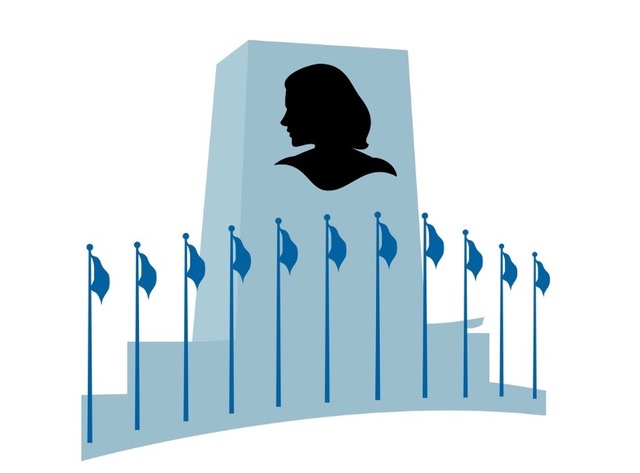
Women are changing both the United Nations' and the world's approach to diplomacy, hunger and food production, the response to the refugee crisis, and much more. They are creating critical policies and partnerships to confront complex and challenging issues.
The Committee on Teaching About the United Nations (CTAUN) presented a webinar featuring dynamic women who have shaped and are shaping a response to global issues.
A recording of this webinar can be viewed HERE
Below is a recap of the webinar:
Chair of CTAUN Anne-Marie Carlson welcomed all to our third webinar, “The Frontline of Change: Women Leaders and the United Nations.” The webinar focused on the impact made by the vision and accomplishments of women from the past and present and includes some leaders whose careers we should follow in the future. She explained that there would be no lengthy introductions, since more information is available on our website.
Mrs. Carlson then introduced the first of our featured leaders, Gillian Sorensen, former Assistant-Secretary-General. She is currently on the Board of the International Rescue Committee.
Mrs. Sorensen began by outlining her own career starting as New York City Commissioner to the United Nations. Her task was to “build bridges” between the diplomatic community and the people of New York City. When she was appointed to the UN, and she was charged with the planning of the UN’s 50th anniversary, she saw it as an opportunity to inspire and inform many different groups about the work of the UN.
She said that despite Eleanor Roosevelt’s unique leadership and critical role at the UN, few women had been appointed; Secretary-General Kofi Annan understood the importance of including women, not for appearance sake but because of what they were capable of accomplishing ; many women were chosen for important posts. Mrs. Sorensen named many of the women that he chose.
Finally, she appealed to the teachers in the audience to encourage their students to follow current issues, to learn how to speak in public, to consider careers in foreign service or politics, and to learn and be fluent in one foreign language or two.
CTAUN member, Diane Paravazian, presented the first Spotlight on a woman leader. She chose Audrey Azoulay, the Director General of UNESCO. Ms.Azoulay sees education as the key to solving global challenges and wants to see students, especially girls, relate in new ways to nature, science, the environment, and culture. The second leader in the Spotlight, Phumzile Mlambo Ngcuka, oversees UN Women, an organization dedicated to gender equality and the empowerment of women and girls. She believes that women must be represented in the heart of all decision-making spaces.
CTAUN member, Joanna Petritsis, introduced Amina Mohammed, UN Deputy-Secretary-General, who is the second highest international civil servant in the world. Ms. Mohammed was instrumental in creating the Sustainable Development Goals, especially on poverty and climate change. Then Ms. Petritsis Spotlighted the new United States Ambassador to the UN Linda Thomas-Greenfield. As part of her goal to renew US relationships with other countries, Ms. Thomas-Greenfield has introduced “Gumbo Diplomacy” what she sees as a way of connecting people and helping them to solve their differences.
Vice-Chair of CTAUN, Grace Murphy, presented the video recording of Michelle Bachelet, the United Nations High Commissioner for Human Rights, by stating that Ms. Bachelet is an agent of change. Although Ms. Bachelet realizes that the hardest thing is to change culture, she fights for the rights of women – their economic empowerment, their right to be included in decision making on all levels, and their right to be free from violence.
Ms. Bachelet began her video presentation by stating that in all the different phases of her life, she has encountered women who inspired her; she feels there would be more such incidents if women were not looked upon with suspicion born of hostility and stereotyping. Even though girls are sometimes taught to think of themselves as inferior, they are capable of incredible things in all fields.
In conclusion, Ms. Bachelet said that as the world struggles to recover from COVID 19, everyone must stand up for change and support human rights.
Lochie Musso, Secretary of CTAUN, focused on three leaders. The first, Alaa Murabit, is the UN High Commissioner on Health, Employment and Economic Growth. She is an award-winning medical doctor, global security strategist and women’s rights advocate. Her TED talk,” What My Religion Really Says About Women,” has been viewed nearly 5 million times.
Next, Mrs. Musso chose Meg Gardinier, Secretary General of ChildFund Alliance. Her leadership helps to protect 14 million children, their families and communities in 70 countries. She is a founding member of the Campaign for US Ratification of the Convention on the Rights of the Child.
Referring to Virginia Gamba, the UN Special Representative for Children and Armed Conflict, Mrs. Musso said that she advocates for Action Plans that keep “the best interest of the child in mind.” Ms. Gamba encourages governments to change policy and create laws to protect children in war zones and provide for their physical, intellectual, and emotional well-being.
CTAUN member Rose Cardarelli introduced Gillian Triggs, Assistant Secretary-General, Assistant High Commissioner for Protection, the Office of the UN High Commissioner for Refugees (UNHCR). Ms. Triggs began her remarks by emphasizing the importance of the International Rule of Law as it affects achieving peace and protecting human rights. She then offered the staggering statistic that there are 82 million displaced persons in the world.
It is the responsibility of the Global Compact for Refugees to help all nations and their citizens understand that everyone must share the responsibility of caring for these refugees. It is a multinational agreement with a mechanism for enforcement, that strives to ease the burden on host countries and increase the self -reliance of the refugees by providing them with opportunities for education and earning a livelihood.
Ms. Cardarelli also introduced Perveen Ali, the organizer of the Global Refugee Forum, an event that will happen every four years and will focus on the pledges made by governments and stakeholders regarding the plight of the refugees. At the Forum in 2019, member states discussed budgets, policy, material and technical support, best practices, and other realistic aspects of achieving the Global Refugee Compact.
Ms. Ali said that the Forum was a unique moment because of the number of participants, because there were representative refugees at the table who were part of the decision making, and because there is a follow-up mechanism to make sure that the promises made there become a reality.
CTAUN Executive Director, Elisabeth Shuman, directed the next Spotlight to Corinne Woods, Director of Communications for the UN World Food Program. Ms Woods works to enhance the visibility and support fundraising for this organization, winner of the 2020 Nobel Prize. It fights hunger worldwide, feeding 86 million people a year.
Her next subject was Rosario Pilar De Garavito, Founder of the Millennials Movement, a social media youth-lead movement which involved hundreds of young people in Peru. They collected valuable information, encouraging people in their own communities to share their opinions. This information helped to shape the SDGs.
Her third Spotlight choice was Eunhee Jung, Founder and President of IVECA – International Virtual Schooling. This method encourages students from around the world to study together and socialize using instructional technology – a way for the students to contribute to peace and sustainable development, to develop respectful relationships with others and to grow as global citizens.
Grace Murphy, CTAUN Vice-Chair, introduced Melissa Fleming, Under-Secretary-General for Global Communications. Ms. Fleming changed things. Faced with the responsibility of reaching millions of people in 60 countries, she decided to use every available media resource to deliver the UN’s message. We are honored that Ms. Fleming joined us on video and to tell us how she faced this 21st century challenge and how she mobilized for change to accomplish her goals.
Ms. Fleming began by noting that communication is undergoing a change, driven by technology. She said that the challenge to inform people about the state of the world and what the United Nations is doing about it is enormous and so she decided that all information would have to be governed by the 3 W’s – What, Why Care and What Now.
The What is accurate content which is why VERIFIED, a UN initiative designed to deliver accurate information, advice and stories about real people, was developed. The Why Care means that all departments should identify and share people-centered stories to make a positive difference. The What Now is to attempt to mobilize individuals and groups to take action.
Ms. Fleming also mentioned her very popular podcast, Awake at Night, on which she interviews UN workers in perilous situations.
CTAUN Vice-Chair Connie Rensink introduced the panel, “No Hunger.” She said that SDG#1 – No Hunger – is complex and requires both systemic change and solutions that meet- current needs. She introduced the three women who are part of this panel: Ismahane Elouafi, Amy Wu, and Cristal Montanez- Baylor. She invited them to talk about themselves and the work they do.
Ismahane Elouafi is the Chief Scientist of FAO. Ms. Elouafi does not believe we will reach the No Hunger goal by 2030 since we are not on track to improve food security, improve nutrition, or promote sustainable agriculture. Changing her focus, she stressed that we need to empower women and girls. They must have opportunities and they must have the freedom to choose their educational path. She spoke about the power of education, mentioning how her own quest increased her love of travel and made her more tolerant, more appreciative of diversity, and more understanding.
Amy Wu is the creator of From Farms to Incubators, a multi-media platform that covers agriculture and technology thru stories of women. Her goal is to increase the presence of women in a traditionally male-dominated field. She believes that STEM education could lead to more interest in farming, especially in small towns where growers face problems caused by climate change and land and water mismanagement. She believes more women should major in agricultural studies.
Cristal Montanez- Baylor is working to help the refugees fleeing to Colombia because of the humanitarian crisis in Venezuela. Ms. Montanez-Baylor and her colleagues responded by distributing meals and supplies needed for protection against COVID. When grant money stopped, she continued her response, but can now only offer soup and, she wishes, some hope to the refugees.
In response to the question: ”What can an educator do to empower girls in your field?” Ms. Elouafi cited the need for mentoring to teach girls how to manage their careers, learn leadership skills, and fight for policy and laws that support women.
Ms. Wu agreed that mentoring is invaluable. She also called for courses in the curriculum that focus on agriculture, presentations at Career Days, competitions and games that have to do with food production.
Ms. Montanez-Baylor called for an emphasis on gender equality and a general need to realize the role of women as leaders.
CTAUN Director-at-Large Peter Brosnan chose three young women for the final set of Spotlight presentations. The first is Jayathma Wickramanayake, The UN Secretary-General’s Envoy on Youth. Chosen in 2019 as one of TIME Magazine’s 100 World Leaders, Jayathma tries to increase the involvement of young people in the workings of the UN by giving them a voice, engaging them, and offering them opportunities for involvement.
Tania Rosas founded the El Origen Foundation in her native country of Colombia, home to millions of indigenous people, many of whom are young. She works with educators and indigenous leaders to give at-risk students a second chance by decreasing illiteracy through a hands-on curriculum, adapted to the locale, language and culture of the community.
The third Spotlight shines on Preva Shomy, the founder of Awareness 360. Preva decided to create an outreach program that would ensure that people in her country had clean water. She delivered WASH talks to vulnerable communities explaining the basic principles of hygiene and the proper technique of hand washing. Awareness 360 seeks to make people aware of the SDGs and other issues. Anne-Marie Carlson thanked the registrants and then the CTAUN Vice-Chairs Connie Rensink and Grace Murphy for producing the content and the technology experts Elisabeth Shuman and Peter Brosnan for their help with this webcast. She announced that the United Nations was producing Virtual tours that are one hour in length; more information may be found on the UN website at UNHQ.org
Further information on the Spotlights and all women leaders plus a Resources list can be found on this website.
We heard from:
Michelle Bachelet High Commissioner for Human Rights, United Nations
A woman of several firsts, Ms. Bachelet was the first woman President of Chile for two terms. She was named the first director of UN Women, an organization advocating for economic empowerment and the end of violence against women and girls. She has a Medical Degree in surgery and has studied military strategy.
Melissa Fleming, Under-Secretary-General for Global Communications, United Nations
A media expert, author of a book, A Hope More Powerful than the Sea, and the host of an award- winning podcast, Awake at Night, Ms. Fleming previously served UNHCR as Head of Global Communications. She designed a multimedia news service to distribute and place stories designed to generate empathy for refugees.
Gillian Sorensen, Former United Nations Assistant Secretary General
Currently serving on the Board of the International Rescue Committee, she is also a Member of the Council on Foreign Relations. She served as Assistant-Secretary-General and was responsible for outreach to all aspects of society. .She has served as NYC Commissioner for the UN and has been a Teaching Fellow at Harvard University.
Gillian Triggs, Assistant High Commissioner for Protection, Office of the UN High Commissioner for Refugees
A highly renowned expert in international law who has held a number of eminent appointments in service to human rights and the refugee cause, she oversees UNHCR’s protection work for millions of refugees, internally displaced, stateless and other people of concern. Recent positions included President of the Australian Human Rights Commission and the Vice Chancellor’s Fellow and Emeritus Professor at the University of Melbourne.
Perveen Ali, Head of the Global Refugee Forum Coordination Team, UN High Commission for Refugees
and Senior Policy Advisor at UNHCR Headquarters in Geneva. She has been working in the field of refugee and human rights protection since 1993 in various locations in the Middle East, Africa, and the United States, previously with NGOs and later with UNHCR. She holds a PhD in Law from the London School of Economics and Political Science and is a national of the United States of America.
Ismahane Elouafi, Chief Scientist, United Nations Food and Agriculture Organisation
Prior to her appointment, Dr Elouafi was Director General at the International Center for Biosaline Agriculture based in the United Arab Emirates. In this role, she spearheaded the development and implementation of the center’s long-term strategy and expanded its mandate to marginal environments, an agroecosystem concept which she helped to mainstream in the global research and development discourse.
Cristal Montanez, Hope for Venezuelan Refugees
Cristal Montañéz Baylor is a humanitarian and philanthropist experienced in citizen diplomacy working in some of the world’s most controversial countries. Cristal is a member of the Rotary e-Club of Houston and the International Coordinator of the Hope For Venezuelan Refugees, a project created to respond to the food insecurity and hunger affecting thousands of Venezuelan refugees, migrants, and walkers “caminantes” in Cúcuta and Pamplona, Colombia. The project received the Rotary Humanitarian Service Project of the Year Award 2018-2019 .
Amy Wu, Farms to Incubators
Amy is the Creator & Chief Content Director of From Farms to Incubators, a multimedia platform that uses documentary, video, photography and the written word to tell the stories of women leaders and innovators in agtech. It has a mission of highlighting women in food, farming, and farmtech, especially women of color. From Farms to Incubators includes an award-winning documentary short that has been screened at SXSW, and a best-selling book “From Farms to Incubators: Women Revolutionizing How Our Food Is Grown” that was released in May 2021.
SPOTLIGHTS:
Audrey Auzuley, UNESCO
Shomy Hasan Chowdhury, Samsung Global-UNDP G17 Ambassador
Virginia Gamba, UNSG Representative for Children and Armed Conflict
Rosario Pilar de Garavito, The Millennials Movement
Linda Thomas Greenfield, US Ambassador to the UN
Meg Gardinier, Child Fund
Eunhee Jung, IVECA
Phumzile Mlambo-Nguka, UN Women
Amina Mohammed, Deputy-Secretary General
Alaa Murabit, UN High-Level Commissioner on Health, Employment & Economic Growth
Tania Rosas, El Origen Foundation
Jayathma Wickramanayake, UN Youth Envoy
Corinne Woods, United Nations World Food Program
RESOURCES
Articles
- Women who shaped the Universal Declaration | United Nations Eleanor Roosevelt's leading role as Chairperson of the drafting committee of the Universal Declaration of Human Rights has been well documented. But other women also played essential parts in shaping the document. Some of them, and their contributions to the inclusion of women’s rights in the Universal Declaration, are featured here.
- Women Leadership | UN News - UN News has many articles regarding women in leadership.
Lessons
- Curriculum & Lesson Plans | USU - These resources provide curriculum and ideas on how to teach content that can strengthen the impact of Utah girls and young women.
- Female Leaders Worksheets & Teaching Resources | TpT - Lesson ideas, games, etc. from free (very few) to $50 but almost all under $5.
- From Where I Stand - This project enables you to think about and contribute to encouraging women and girls to have equal opportunities to be heard and to have real opportunities to participate in all political, economic and public spheres.
- Mission: Gender Equality - Through group discussion and research, students will examine the need for action on SDG 5 Gender Equality.
- Teach a Girl to Lead Teaching Toolbox - Whether you’re a teacher, a group leader, or an interested parent or friend, these tools will help you bring women’s political history and leadership into classrooms, youth programs, field trips, and beyond.
- The World's Largest Lesson - World’s Largest Lesson promotes use of the Sustainable Development Goals in learning so that children can contribute to a better future for all. A programme from Project Everyone.
Organizations
- ReflectUS Coalition Members - “ReflectUS is a national, nonpartisan coalition of the leading women’s representation organizations working to increase the number of women elected and appointed to public office at the local, state and national levels.
- UN Women - UN Women is the United Nations entity dedicated to gender equality and the empowerment of women. A global champion for women and girls, UN Women was established to accelerate progress on meeting their needs worldwide.
- Women Deliver - Women Deliver is a leading global advocate that champions gender equality and the health and rights of girls and women.
Programs
- EMERGE - Programme for Emerging Women Leaders | Centre for Learning and Multilingualism - The Programme for Emerging Women Leaders, an innovative initiative jointly developed by 11 UN entities - ILO, ITU, OCHA, OHCHR, UNAIDS, UNHCR, UNICEF, UNOG, UNSSC, WHO and WIPO, is part of a renewed and sustainable effort to tap into the leadership potential of female staff members within the UN system.
- The Generation Equality Forum is a global movement for gender equality, convened by UN Women and co-hosted by the governments of Mexico and France. The Forum brings together governments, corporations, NGOs, youth-led groups and Foundations to secure concrete, ambitious, and transformative commitments for gender equality.
Videos about women or related issues
- A Global History of Women’s Rights in 3 minutes - Discover the noteworthy women, grassroots movements and historic milestones that have changed the world for women and girls.
- Rise for All - “Rise for All” is a new initiative that brings together women leaders to mobilize support for the UN Recovery Trust Fund and the UN roadmap for social and economic recovery, as laid out in the new United Nations Framework for the immediate socio-economic response to COVID-19.
- UN Women Youtube Channel - Collection of videos related to the United Nations that champion women and girls.
- What it Takes to Lead - Inclusive and diverse feminist leadership is key to sustained global development as the world continues to confront urgent challenges.
Speaker Resources
- Melissa Fleming
- A Hope More Powerful than the Sea - The stunning story of a young woman, an international crisis, and the triumph of the human spirit.
- Awake at Night Podcast - How are health workers, humanitarians, human rights advocates and peacekeepers working to protect people and helping them to thrive? Stationed in remote locations and witness to suffering and atrocities, how are they coping themselves? To find out, Melissa Fleming meets them.
- Cristal Montañéz Baylor
- Hope for Venezuelan Refugees - The Hope For Venezuelan Refugees Project is helping alleviate hunger and improve the condition of malnutrition among vulnerable Venezuelan refugees, migrants and walkers “caminantes” in Colombia through the donation of RAH meals and food commodities.
- United4Change Center - United 4 Change promotes social justice and peace through collaborative partnerships that empower marginalized groups, creating conditions for self-directed, dignified, and sustainable existence.
- Amy Wu
- From Farms to Incubators: Women Innovators Revolutionizing How Our Food Is Grown - From Farms to Incubators presents inspiring stories and practical case studies of how women entrepreneurs from diverse cultural and ethnic backgrounds are leading the agtech revolution.
- https://vimeo.com/267476596/8391abc4b4 - Documentary From Farms to Incubators - stories of women leaders in Ag Tech
Spotlight Women Leaders
- https://en.unesco.org/director-general The 39th session of UNESCO’s General Conference elected Audrey Azoulay as Director-General of UNESCO
- https://bd.linkedin.com/in/shomy-hasan-chowdhury - Shomy Hasan Chowdhury is a multi-award winning Water, Sanitation and Hygiene (WASH) activist from Bangladesh, with a vision to ensure access to WASH for all.
- https://childrenandarmedconflict.un.org/about/the-mandate/special-representative/virginia-gamba/ - For the position of Special Representative of the Secretary-General for Children and Armed Conflict, the Secretary-General has appointed Virginia Gamba of Argentina.
- https://childfundalliance.org/about/our-people/secretariat/39-meg-gardinier - Meg Gardinier is the Secretary General of ChildFund Alliance
- https://www.linkedin.com/in/eunheejung - Dr. Eunhee Jung is the Founder and President of IVECA Center for International Virtual Schooling and serves as CEO of IVECA-KOREA.
- http://www.website.iveca.org/board-team - The IVECA Center supports all levels of schools and universities across the world to participate in its global collaborative learning program called IVECA (Intercultural Virtual Exchange of Classroom Activities). The program aims to promote interculturally competent global citizens for peace and sustainable development.
- https://pe.linkedin.com/in/rosariodiazgaravito - Rosario del Pilar Diaz Garavito, Founder & CEO, The Millennials Movement
- https://www.unwomen.org/en/about-us/directorate/executive-director/ed-bio - Phumzile Mlambo-Ngcuka is United Nations Under-Secretary-General and Executive Director of UN Women
- https://www.un.org/sg/en/dsg/index.shtml - Ms. Amina J. Mohammed is the Deputy Secretary-General of the United Nations and Chair of the United Nations Sustainable Development Group.
- https://alaamurabit.com/ - Alaa Murabit is an award-winning medical doctor, global security strategist, women’s rights advocate and United Nations High-Level Commissioner on Health, Employment & Economic Growth and Sustainable Development Goal Global Advocate.
- https://www.un.org/youthenvoy/tania-rosas/ - Tania Rosas, a 28-year-old from La Guajira – Colombia, founded El Origen Foundation, an indigenous-first model that provides at-risk youth with a second chance at education and works to close the illiteracy gap for indigengous youth, and launched O-lab, the learning app adapted for indigenous students who have the lowest education levels worldwide.
- https://usun.usmission.gov/our-leaders/our-ambassador/ - Ambassador Linda Thomas-Greenfield was nominated by President Joseph R. Biden, Jr. to be the Representative of the United States of America to the United Nations as well as the Representative of the United States of America in the Security Council of the United Nations on January 20, 2021.
- https://www.un.org/youthenvoy/about/ - United Nations Secretary-General António Guterres has appointed Jayathma Wickramanayake of Sri Lanka as his next Envoy on Youth.
- https://www.unyouth2030.com/ #Youth2030 is an ambitious system-wide strategy to guide the United Nations and its partners to work meaningfully with and for young people around the world.
- https://www.linkedin.com/in/corinne-woods-2b675a5b - Corinne Woods Director Of Communications at United Nations World Food Programme
Eleanor Roosevelt
- “My Most Important Task” Eleanor Roosevelt and the Universal Declaration of Human Rights - Roosevelt House Public Policy Institute at Hunter College - This exhibit celebrates the leadership of Eleanor Roosevelt in writing the Universal Declaration of Human Rights.
- Eleanor Roosevelt and the United Nations - US National Archives — Google Arts & Culture - Exhibit created by the Franklin D. Roosevelt Presidential Library and Museum
- How Eleanor Roosevelt Pushed for a Universal Declaration of Human Rights - Article by History.com
- Eleanor Roosevelt and the United Nations - Article and questions by Bill of Rights institute
- Eleanor Roosevelt at the United Nations: “Diplomacy from Below” - Research by Raffaella Baritono
- Eleanor Roosevelt National Historic Site (US National Park Service) - Visit the home of Eleanor Roosevelt and other resources and videos.
- About the Eleanor Roosevelt Papers Project | Eleanor Roosevelt Papers Project - The project is working to publish both digital and print editions of Eleanor Roosevelt's political papers.
- How One Woman Changed Human Rights History - article by the United Nations Foundation
- 10 Inspiring Eleanor Roosevelt Quotes | unfoundation.org

